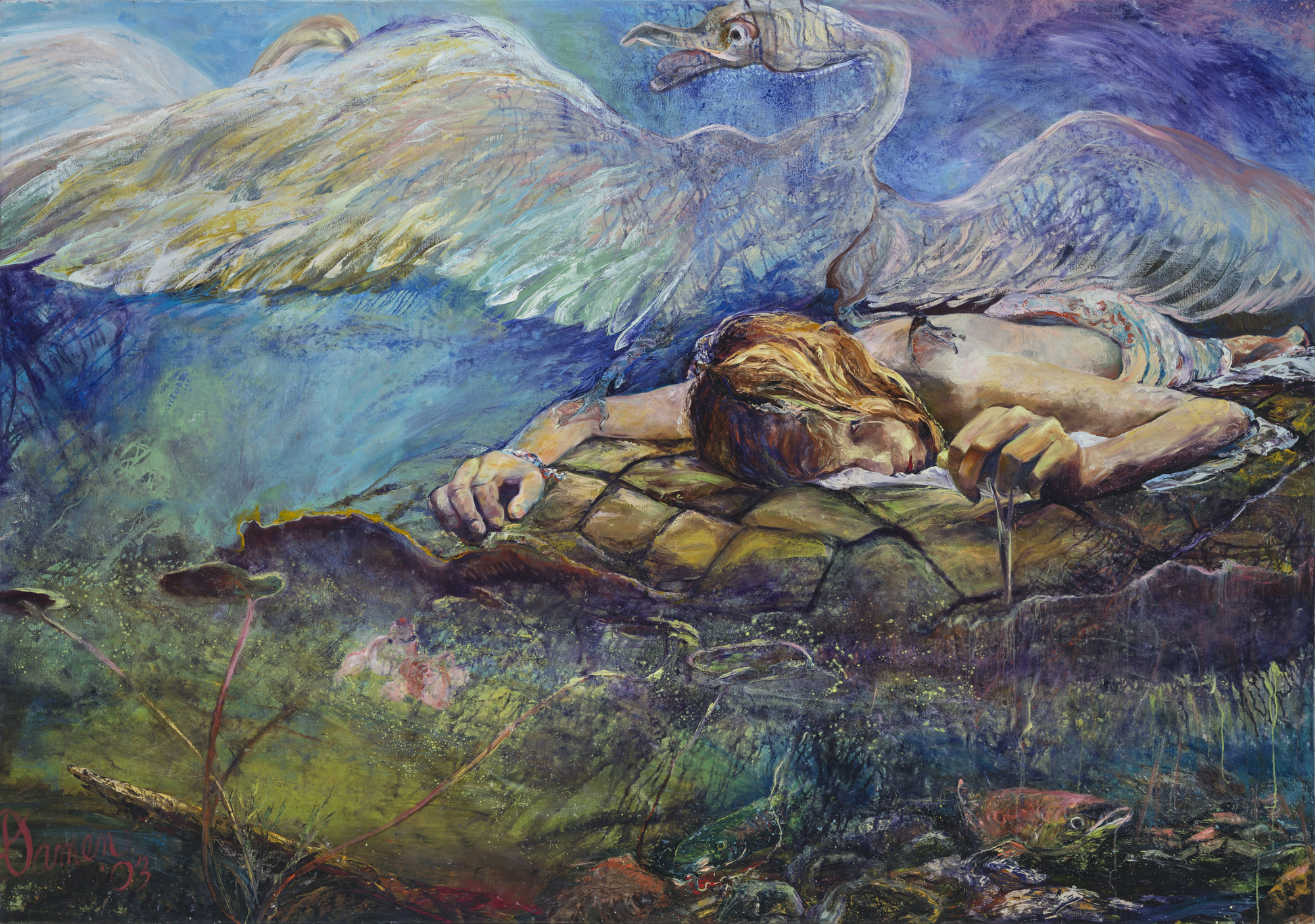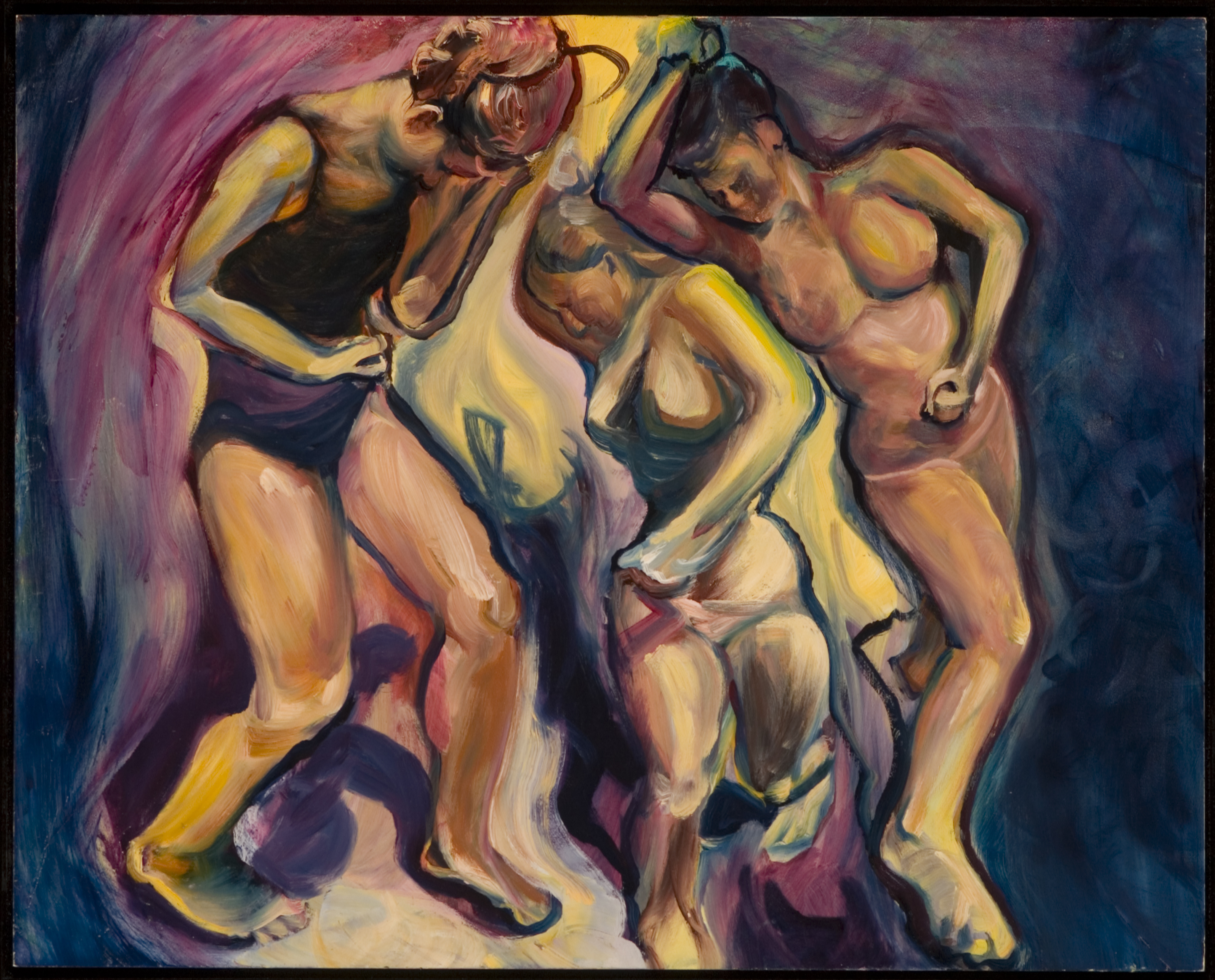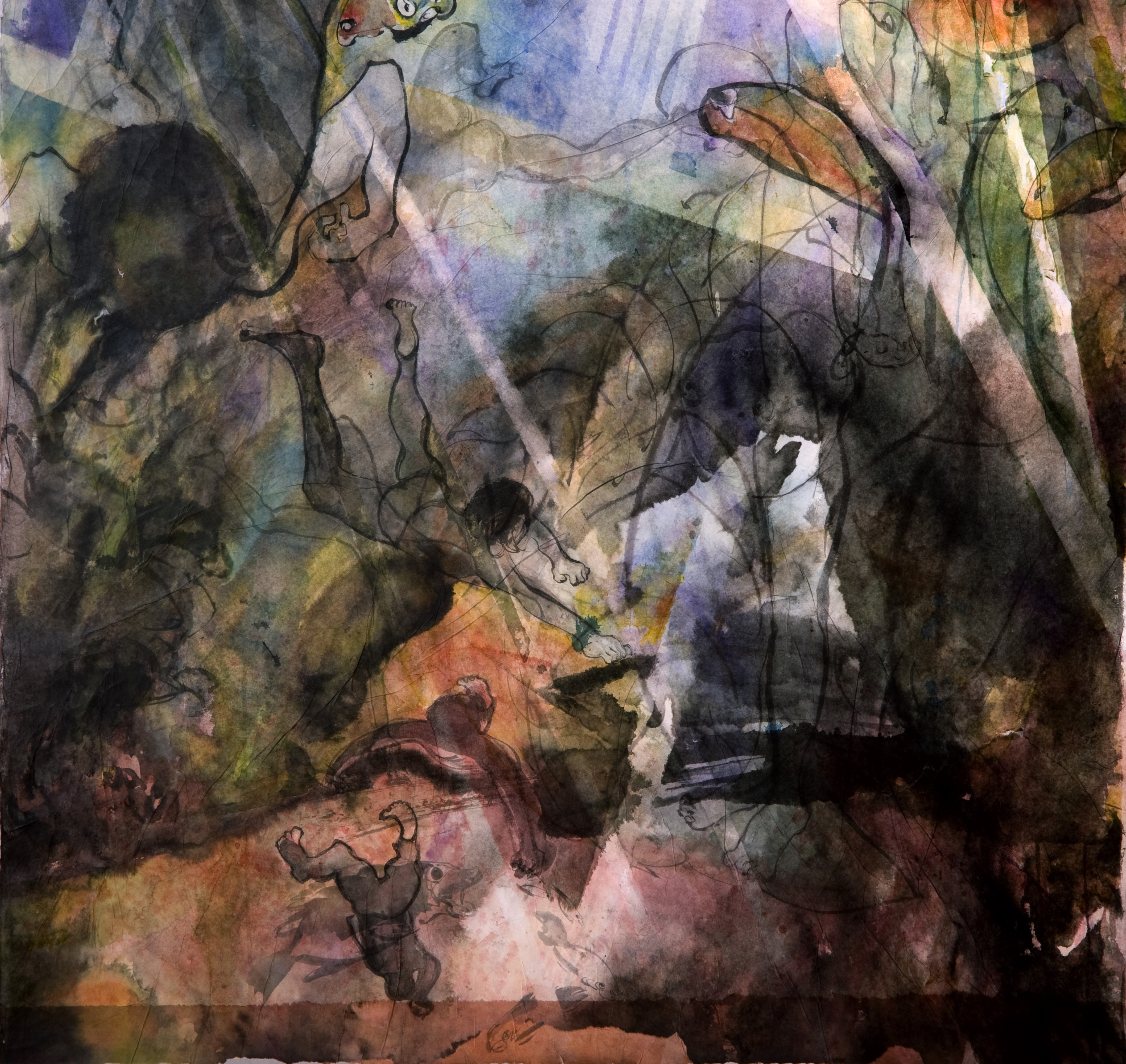Work samples
-
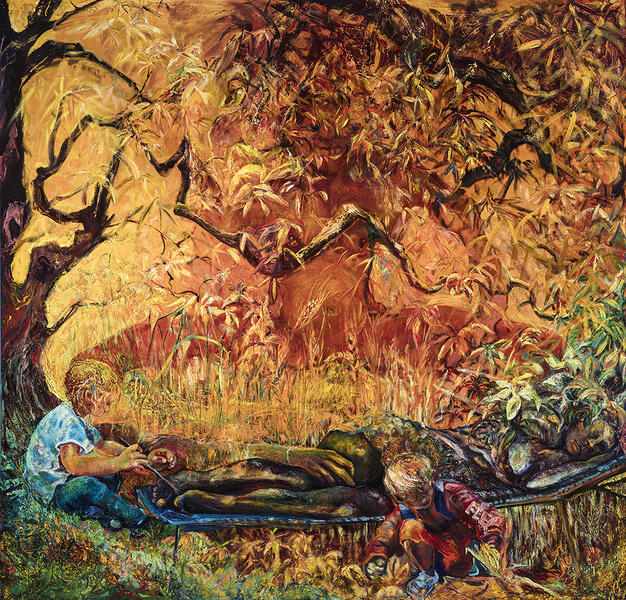 Our Mothers' Repose - Kali and Persephone
Our Mothers' Repose - Kali and PersephoneOur Mother's Repose: Kali and Persephone, 76 x 80", oil on canvas, 2023
Within this dense autumnal tableau are unlikely goddess companions: the Hindu Kali and the ancient Greek goddess, Persephone. Kali embodies the untamed essence of womanhood, representing a profound archetype of feminine creation and destruction. Persephone evolves into an enigmatic goddess of the Underworld. She emerges as a symbol of resilience, transformation, and the cyclical nature of life.
As autumn ebbs Persephone’s reprieve from Hades’ world of death ends. Lurking amongst harvested wheat sheaves and abundant golden leaves is Kali. She is furious, her outstretched legs and upraised arms encompass the supine man, Persephone, and the oblivious children. Created here is a pivotal moment in time. Winter is certain but will destruction prevail?
-
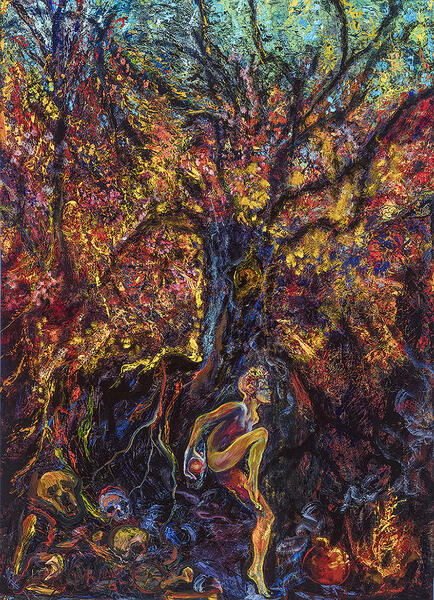 Persephone Breaking Out
Persephone Breaking OutPersephone Breaking Out (30 x 22", oil on linen, 2023) is a reimagined myth of Persephone's descent into the realm of shadows not as a tale of victimhood, but a transformative odyssey. Here, the figure of Persephone enclosed by skulls and deep shadows is springing out of the dismal hold, grasping a round orb in her hand. Amid the darkness, Persephone discovers her own power and agency. Her story becomes a metaphor for resilience and the capacity to find light even in the bleakest of circumstances. The pomegranate, a symbol of both temptation and hidden wisdom, becomes a focal point alongside a blooming tree representing Persephone's choice and the knowledge gained through her trials.
-
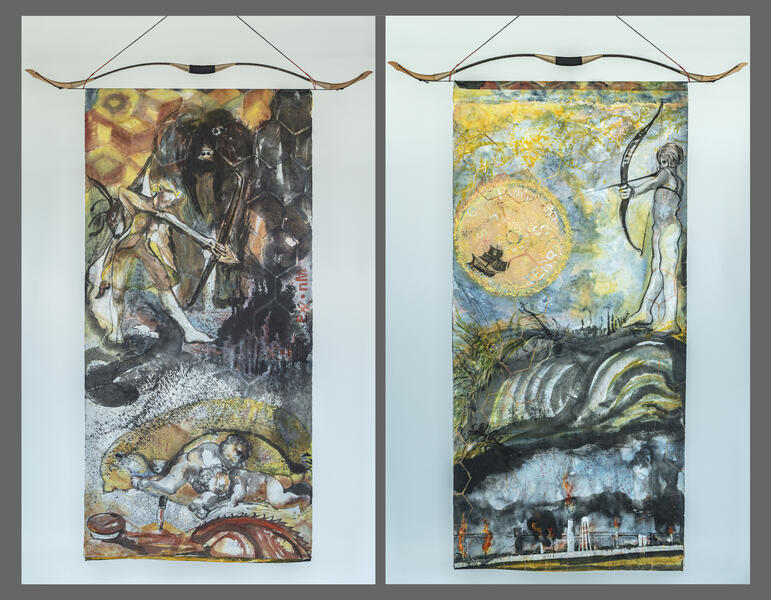 Artemis: Slayer of Methane Monsters, Protector of Life
Artemis: Slayer of Methane Monsters, Protector of LifeTwo 84 x 40" ink, watercolors on Japanese papers, 2022. The two transparent sheets of paper are glued together to make one free hanging scroll, entitled, "Artemis:Slayer of Methane Monsters, Protector of Life". The scroll is hung from a wood archery bow. The archetype goddess, Artemis, is portrayed as an archer protecting her cubs on side A and on side B, as a girl aiming her bow toward the worse US methane polluters. Those polluters are identified within a glowing circular globe. Young Artemis stands upon a field of melting permafrost as an oil refinery is spewing its warming carbon dioxide into the atmosphere.
-
Artemis Movement
Movie of "Artemis: Slayer of Methane Monsters, Protector of Life" (84 x 40", ink, watercolor, painting on Japanese paper scroll, sides A & B, 2022) which slowly rotates from a long wood bow. As the scroll rotates viewers see a changing vision of Artemis as both huntress and protector. Light goes through the translucent mulberry Japanese papers allowing viewers to see a diffused view of the other side adding to the complexity of the image.
About Jessica
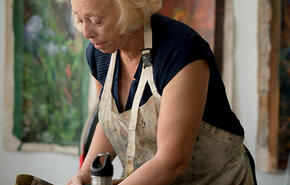
Beginning with my desire to delve into psychological understandings for my imagery, I found that ancient myths are an excellent prism through which I can reveal forbidden or repressed wishes and desires. While in art school I began painting stories about children, not as an adult’s idealized projection, but more honest narratives that reveal their sometimes frightening and whimsical worlds.
In 2004 Grace… more
Resilience and Reimagining: The Feminine Narratives of Jessica Damen - Leda and Ariadne
Resilience and Reimagining: The Feminine Narratives of Jessica Damen aligns my identification of female mythological characters with feminine strength and resiliency by retelling stories predicated upon patriarchal assumptions regarding rape, female agency, and gender identification. Mythological characters serve as a conduit for revealing repressed or unacceptable feelings. Although, these goddesses and mortal characters are often understood as victims or single dimensional personalities, my reenvisioning create compelling, multidimensional characters with complex narratives that resonate with contemporary audiences.
Beginning with the sordid story of Leda’s raped by Zeus, the myth describes a typical patriarchal story. Zeus is attracted to Leda’s beauty, the god “can’t help himself”, he disguises himself as a swan, so that Hera, his goddess wife, does not notice his rape of Leda. During my decade long re-envisioning of this myth, I first dispel the notion that the god/swan was a beautiful and desired creature. Instead, he is a monster bird, full of possessive rage and weaponized talons. Leda is overtaken but, the painting’s focus on Leda and her strength powerfully expressed through brushstrokes and dramatic color. As the series progresses, I imagine Leda’s psychological coping, her revenge, and her spiritual uplifting. Her dance outshines the god/swan. Ariadne, another “long-suffering” females enables Theseus to slay the half man/bull beast, the Minotaur, as well as provide for his escape from the labyrinth. But Theseus, this "so-called" hero is so afraid of his father's disapproval of Ariadne, well the coward abandons her on an island. My reimagining of this too familiar female tale of betrayal pictures Ariadne as a woman with support “sisters”. She struggles through his betrayal and still she emerges as as one who seeks both revenge and individuation. Ariadne, a daughter of Zeus and the original “rebel girl” is reimagined as a multidimensional character. She is both a lethal huntress and a protector. In my re-telling I see Ariadne as the goddess who can save our earth. She is both protector of young life and slayer of those who would destroy it. Persephone, abducted by the underworld god, Hades is also described as a hapless young woman. She too finds her strength to escape. Later I envision Persephone in repose before her return to the underworld. Lurking behind the pastoral autumn tableau is Kali, Hindu goddess of destruction and creation. She is fearsome and formidable. Her wrath can barely be contained. Will Persephone's stubborn resilience intervene? Will other autumns be as gorgeous as the one in "Our Mother's Respose - Kali and Persephone"?
Each of these mythological characters confront issues relevant to our collective understanding of gender, power, and agency. Can we find the goddesses within ourselves and recognize the myths which hold us back? Can we push back the forces restricting female agency, gender limitation and sexual violence?
-
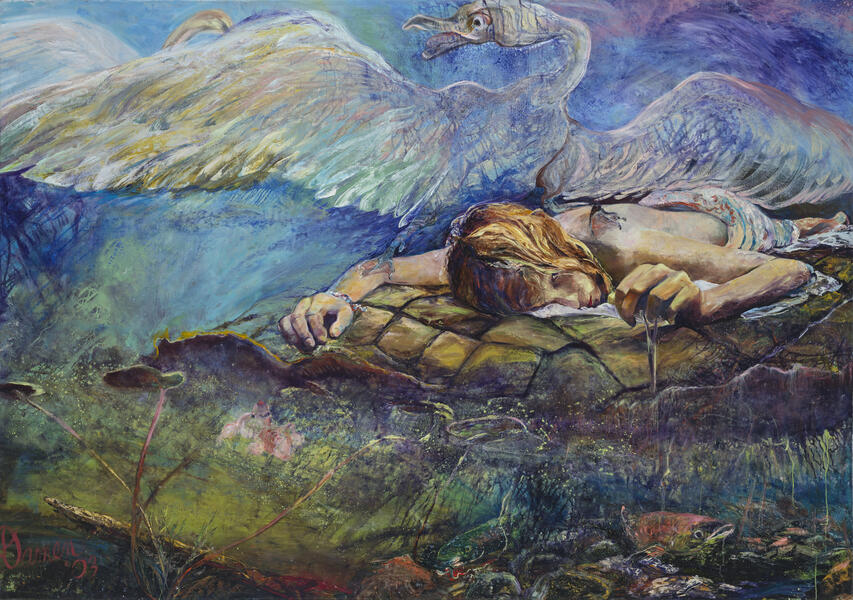 Leda and the Angry Swan
Leda and the Angry SwanLeda and the Angry Swan, (72 x 102 x 3", oil on canvas, 2003) begins with the sordid story of Leda’s raped by Zeus. The myth describes a typical patriarchal story. Zeus is attracted to Leda’s beauty, the god “can’t help himself”and he disguises himself as a swan so that Hera, his goddess wife, does not notice his infidelity. Leda's story is generally told as one of violation and victimhood but my Leda defies this traditional visualization. In my painting, the swan's shadow, once a symbol of coercion, is replaced by Leda's unwavering gaze, reflecting her determination and empowerment.
With textured paint and a vivid palette I create a mythic space where Leda's agency shines brightly. Leda is not silenced. Leda is overtaken but, the painting’s focus on Leda and her strength is powerfully expressed through brushstrokes and dramatic color. Her strong woman spirit is evident. Where ever the viewer stands her eye, the window into her soul follows the viewer.
During my decade long re-envisioning of this myth, I first dispel the notice that the god/swan was a beautiful and/or desired creature. Instead, he is a monster bird, full of possessive rage and weaponized talons. As the series progresses, I imagine Leda’s psychological progression, her surprise and denial, her defiance and vengeful wishes. Finally there is a spiritual uplifting and her dance outshines the god/swan.
-
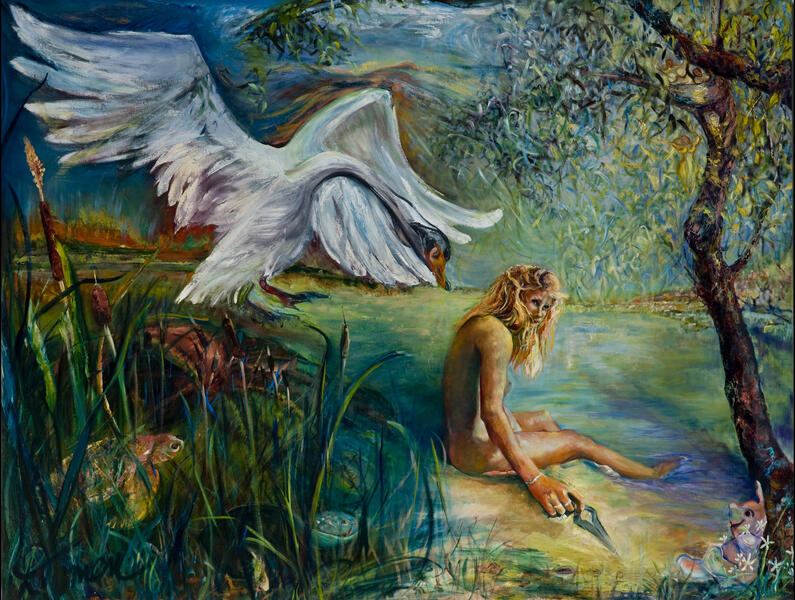 What's This - Prequel
What's This - PrequelWhat's This - Prequel (60 x 79", oil on linen, 2016) was painted in response to opening lines from Maj Ragain's responsive poem, to my painting, Leda and the Angry Swan. Ragain's verse, "I (Leda) lie in the wrecking of my longing, which called him (Zeus) down to me."*
I read his opening verse as a judgment against and the patriarchal assumption that the mythical Leda had asked to be raped. This painting is a response to those lines. Maj's poem, Leda's Voice, Under Sky, Over Water is also a sensitive expression of the lost of selfhood experience by one physically violated. He concludes with, "I am sore. The Milky Way swims in my belly. /Wherever you go, my empty eye follows."
In response I show a woman oblivious to the threat behind her. She is calmly taking her bath. She wonders, what is that breeze? The swan has overextended his neck, ready to clasp her, his powerful wings flapping. The background environment is aflame. But, there is also stasis before the storm. Where is the longing? Except expressed by the perpetrator?
-
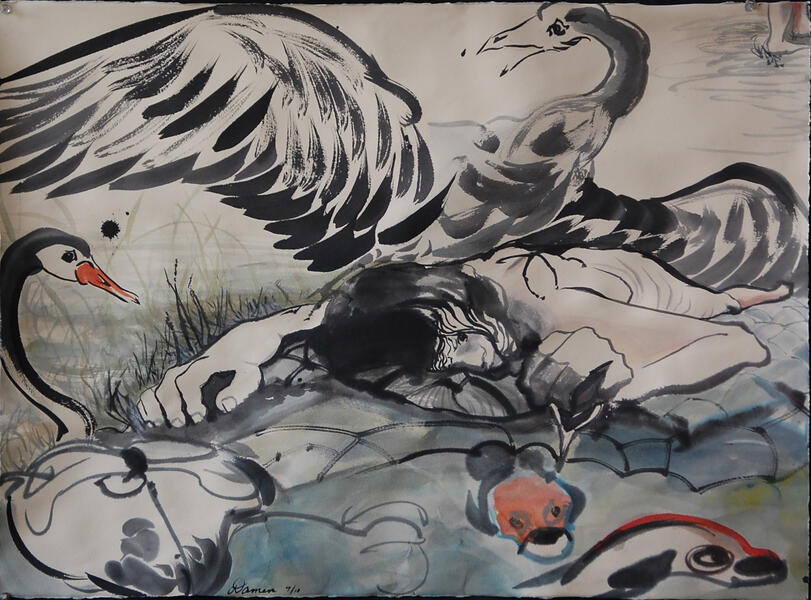 She Walked Away
She Walked AwayShe Walked Away in Her Mind (22 x 30", Chinese ink, watercolor on Archer paper, 2010), understands the defense mechanism of disassociation. I imagine Leda so traumatized that her only defense is her imagining she is leaving the scene. The ink is heavy and the world is indifferent to her plight.
-
 Leda's Revenge, for Those Who Have Wanted to Kill Their Rapists
Leda's Revenge, for Those Who Have Wanted to Kill Their RapistsLeda's Revenge for Those Who Have Wanted to Kill Their Rapists (11 x 14 x 3", oil on wood panel, 2014) is undergirding patriarchy's long prurient fascination with rape are many assumptions. One such assumption is that rape is to be quietly endured. The feminist progress of the latter half of the twentieth century began to reverse the lonely trauma of rape and unintended and unwanted children. Yet, with the stealth of a disguised swan, reactionary forces are methodically at work to undo that progress. To be a revenger is just one psychological step needed for an individual to integrated the trauma of rape.
-
 Leda Dancing I
Leda Dancing ILeda Dancing I (30 x 22" Ink, watercolor on Archer paper, 2012). I changed the Dancing Leda series format from horizontal to vertical to indicate Leda's liberation from Zeus' violation. During my own journey from 2003 to 2016 Leda psychologically evolves as a subject-from defiant victim, to revenger, to a dancer with fingertip heavenward as a hopeful sign of her transcendence.
-
 Shadows - Ariadne
Shadows - AriadneShadows (37.25 x 29.5", oil on linen, 2008) pictures Ariadne as an idealized young woman holding a candle. She confronts the Minotaur's shadow, the half man/bull beast, also her brother.
In my reimagining of this tale of an abandoned and betrayed woman, I see the mythological figure of Ariadne emerging as a beacon of feminine resilience and complexity. In the ancient Greek tales, Ariadne was overshadowed by the exploits of Theseus. The Surrealists, including Pablo Picasso were mesmerized by the dual nature of man and the idealistic idea of an innocent girl who can lead conflicted man out of darkness. However beginning with Shadows, I posit a more nuanced, complicated image of Ariadne. She stares straight at the Minotaur's shadow, becoming a metaphor for the intricate mazes that constitute women's experiences.
-
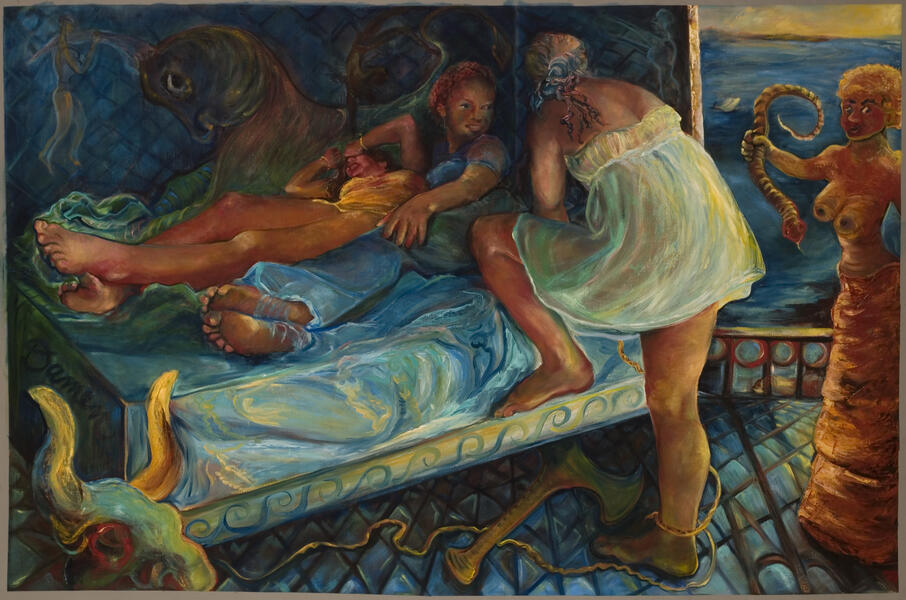 Jumping Bulls - Ariadne
Jumping Bulls - AriadneJumping Bulls – Ariadne (52 x 77 x 3", oil on linen, 2008) pictures Ariadne communing with her “sisters”. Here she is part of a sisterhood, friends to whom she can reveal her hidden secrets. Ariadne’s back is to the viewer her pose is secure wearing a translucent dress that reveals her muscular legs. Her solid body in brilliant light is augmented by the adjacent ancient bare breasted Crete goddess boldly holding a slithering snake, symbol of women’s creative transmutative power. Behind the bed is a shadowed mosaic depicting a woman who is about to jump a bull. The entire tableau indicates beauty and self- assurance. Ariadne has not yet fallen in love with Theseus. He will be her first heroine’s challenge.
-
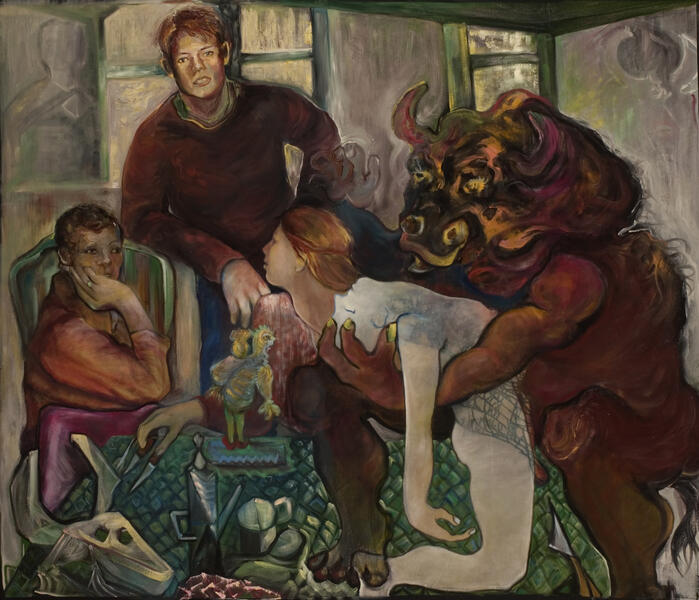 Who Opened The Window - Ariadne
Who Opened The Window - AriadneWho Opened The Window - Ariadne (66 x 77 x 3", oil on linen, 2008) is a question that comes to mind when seeing this bizzare scene. This contemporary dinner scene opens with a surrealist’s nightmare. Bestowing homage to Pablo Picasso’s fascination with the Minotaur as the over sexualize man/beast reflecting man’s dual nature I provide equal space and contrast by bestowing my contemporary dinner guests with calm. The dichotomy is a bit preposterous and the chicken is conducting the joke.
-
 Epic Wrestlers - Ariadne
Epic Wrestlers - AriadneEpic Wrestlers - Ariadne (63 x 127 x 3", oil on canvas, 2009) The representation of Ariadne's internal struggle for self-discovery and individuation is illustrated as two women wrestling along the 127 inch horizontal plane. Their strained moves mirror the pull and push of internal anguish: recrimination, anger, relinquishment and resolution. The Ariadne pictured here is not a passive victim but a powerful archetype, reminding viewers of the multifaceted nature of femininity. Through rich textures of their hair, facial and muscular expressions and with vibrant hues, the female archetype’s emotional journey illustrate the highs and lows, the moments of despair, and the triumphs of self-discovery.The labyrinth, once a symbol of entrapment, transforms into a metaphor for self-exploration and the intricate paths women tread in their pursuit of identity and agency.
-
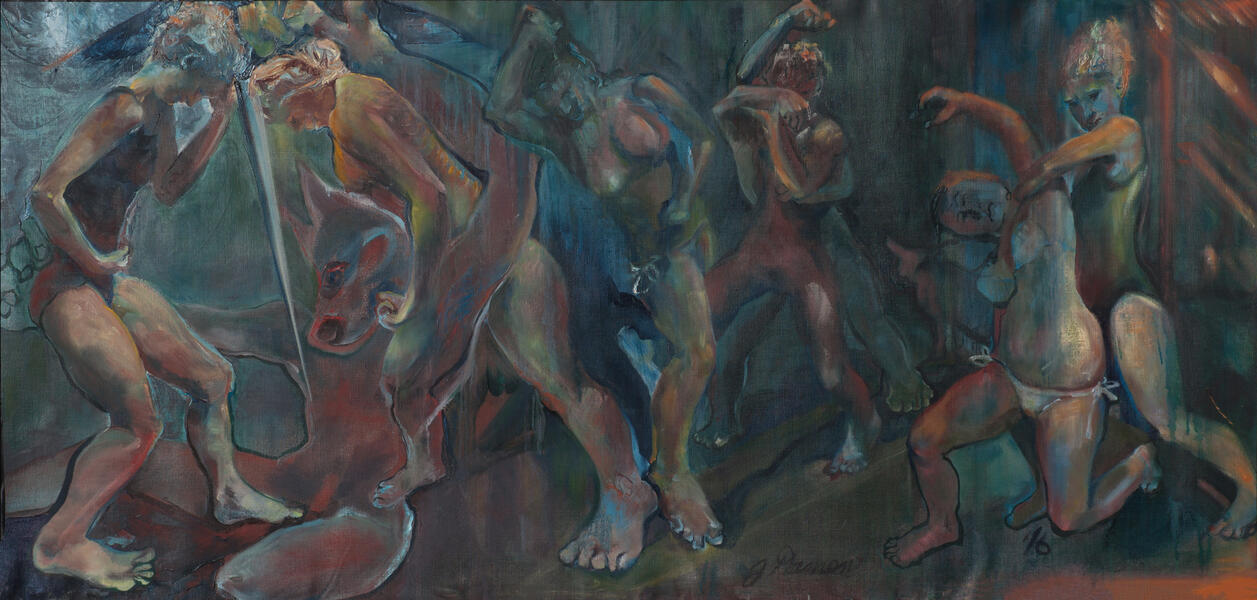 Ariadne's Triumph
Ariadne's TriumphIn Ariadne's Triumph (25 x 55 x 2.5", oil on linen, 2016), Ariadne stands triumphantly above the reclining Minotaur a raised sword in one hand that she’s about to thrust into his gut. The shadowed washes suggest interior space and that her internal struggle is nearly resolved. She has found her way through the labyrinth and is ready to slay her inner monster.
This painting directs the viewer to the power of reimagining ancient myths through a feminist lens. Now Ariadne’s story, once confined to the annals of Greek mythology, transcends time and space, inspiring contemporary audiences to embrace the complexities of femininity and celebrate the strength found in embracing one's unique path. The re-told story of Ariadne is the story of every woman. She is an active architect in her journey negotiating life's labyrinthine twists and turns.
Visions Verses Voices - An Immersive Installation: Painting/Verses 2019-2021
Visions Verses Voices is an ongoing immersive project showcasing paintings inspired by poems that enrich my love for verse in dialogue with my visual imagery. This portfolio offers a glimpse into my work from 2021 and pieces featured in the original 2019 Visions Verses Voices exhibition at the Delaplaine Art Center in Frederick, MD. The inception of a new direction began with "Artemis Rising" in 2020, where I explored my emotional response to poems addressing land, water, animals, and the future threatened by global climate change.
The confinement of 2020 fueled a burst of energy in early 2021, resulting in two new series inspired by poems that resonated with me. I approached the Visions Verses Voices project with a renewed focus—seeking ways to visually represent global climate change without being didactic and terrifying, despite its overwhelming enormity. Fortunately, I discovered poems like "Mother of the Bay” by Dr. Michael Salcman and “Death of the Field” by Paula Meehan, which lyrically spoke of Earth's beauty and the consequences of pollution and inaction, providing a springboard for my paintings.
In the initial presentation at the Delaplaine Art Center in December 2019, twenty-six paintings and twenty-five poems were featured, spanning from 2003 to 2019. Various individuals, including professionals like Tom Hall, program host at WYPR, singers, amateur actors, and interested individuals, read the poems. Their unique voices conveyed their love for the verse, enhancing the interplay of verses and visions strategically placed throughout the gallery.
Poems by Tim Joyce, Janet Lewis, Wilfred Owen, and my long-time poet collaborator Maj Ragain accompanied the paintings. Some of Maj Ragain's poems were written responsively after seeing my artwork, creating a dynamic interaction between the two art forms. The paintings and poems of Visions Verses Voices are like companions strolling along a path—distinct in personality, sometimes sharing sights and insights, and at other times diverging and reinterpreting thoughts, moods, stories, and visions.
My personal life infuses my emotive, expressionistic, and color-filled responses. While the artworks never illustrate, they illuminate my idiosyncratic vision. Both poetry and painting, in my opinion, thrive when they maintain a sense of mystery that encourages the viewer and reader's imagination.
As an ongoing project, some artworks in this current portfolio lack recorded readings. For the latest recordings, visit the exhibition's website: (https://visionsversesvoices.com/).
References:
- Paula Meehan, "Death of a Field," from "Painting Rain," Wake Forest University Press, Winston-Salem, NC, 2009, pp. 14-14.
- Paula Meehan, "The Solace of Artemis," first published in the Notre Dame Review, Fall 2012.
- Dr. Michael Salcman, "Mother of the Bay," from "The Enemy of Good is Better," Orchises Press, Washington DC., 2009, revised in "Necessary Speech: New & Selected Poems," Spuyten Duyvil, NY, 2022.
- Janet Lewis (1899-1998), all poems from "Poems Old and New 1918-1978."
- Maj Ragain (1948-2018), "Clouds Pile Up in the North: New & Selected Poems," Press 53, Winston-Salem, NC, 2017.
Special thanks to Lindsay Bottos, multimedia artist, for her expertise in collaborating on the production of the soundtracks.
-
 Artemis Rising
Artemis RisingArtemis Rising (81 x 12", oil on linen 2022) is inspired by Paula Meehan’s poem, “Solace of Artemis." It can be viewed as if you were studying a Chinese scroll. It slowing reveals the narrative while your eye moves from one space to another. "I read that every polar bear alive has mitochondrial DNA from a common mother, an Irish brown bear who once roved out across the last ice age, and I am comforted." My mythological paintings are comforting and also thoughtful. This painting is in a private collection.
-
The Solace of Artemis read by Olivia Hollander
Olivia Hollander's reading of Meehan's "The Solace of Artemis" captures an undercurrent of intensity. Used with permission by Irish poet and playwright, Paula Meehan's poem “The Solace of Artemis” was first published in the Notre Dame Review in the fall of 2012.
-
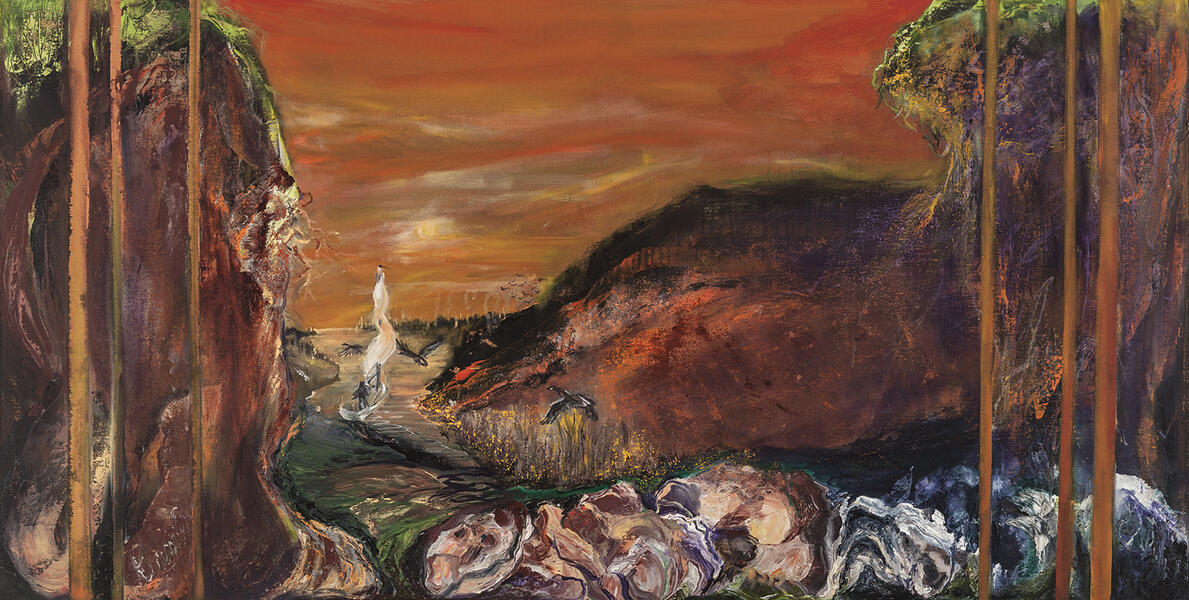 Bottle-Necked
Bottle-NeckedBottle-Necked (27 x 54", oil on canvas, 2021). Here, the sailor and boat squeeze through a bottle necked passage. This great Bay was once known as the "great river, where strange fish with hard coverings lay" is now almost laid waste by "poison today gathered from coalfields, blooming algae, in silt and debris, trapping oyster and crab in nitrate and shale, drowning life in life." Once, there were mountains of oysters and the water was a blue as a clear sky, this largest of estuaries. Next hear Dr. Salcman read his poem, "Mother of the Bay."
-
Mother Of The Bay, poem read and written by Dr. Michael Salcman
"Mother Of The Bay" read by its poet Michael Salcman M.D. The poem is introduced with the piercing noise of low flying geese. His reading fallows the flow of the river, through history, fields, factories until we reach a prayer for its survival and renewel. "Mother of the Bay" was first published in Connecticut River Review, 2006. First collected in Salcman's The Enemy of Good is Better, Orchises Press, Washington D.C., 2011. Reprinted & revised as above in Salcman's Necessary Speech: New & Selected Poems, Spuyten Duyvil, New York, 2022.
-
 Green Night
Green NightGreen Night (54 x 27", oil on canvas, 2021) is inspired by Salcman's poem, "Mother of the Bay" and an ode to the Chesapeake Bay and a prayer for its survival. I envision the Bay under a poisonous green sky, forbidding and ominous, a sailor and his boat squeeze pass towering cliffs with "a million oaks, their stances cocked on cliffs, their branches burning..." You can hear Salcman's reads his powerful poem, a message of warning and hope in Vision Verses Voices portfolio.
-
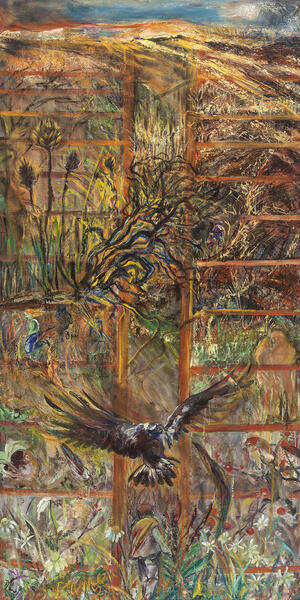 Lost Songs As Night Approaches
Lost Songs As Night ApproachesLost Songs As Night Approaches (54 x 27", oil on canvas, 2021) is inspired by Meehan's "Death of a Field" where we see a multitude of life in a field. "The field itself is lost the morning it becomes a site..."The memory of the field is lost with the loss of its herbs". First scent gone and then "...the memory of the field disappears with its flora: Who can know the yearning of yarrow", "the end of hidey holes. Where first smokes, first tokes, first gropes, Were had to the scentless mayweed." It is a sad long list of lost birds, plants, abundant and playful place.
-
 Leaping Into Eel's Death Colors
Leaping Into Eel's Death ColorsLeaping Into Eel's Death Colors (81 x 12", oil on canvas, 2017) is a response to Maj Ragain's introduction to "Home to the Sargasso Sea." “Every writer finds a new entrance into the Mystery”. An entrance into my painting was found while contemplating Maj's remembrance; a farm's well is getting cleaned and then an eel is felt and a terrified man begs to be lifted. The eel miraculously journeyed from Sargasso Sea to an Illinois farm. The boy witnesses, "The body of the eel still thrashes and churns in the ocean of memory, then dances like a hanged man at the end of a rope. A life hardly contained by its form. A living beauty like nothing I’d ever seen. Her death colors came from a place deeper than the well. The (farm's) well is still there, open all the way to the Sargasso. In the darkness, something turns." Ragain, Maj. "Clouds Pile Up in the North: New & Selected Poems. Press 53, Winston-Salem, 2017. p xiv
-
About Home to Sargasso Sea: A Poem Not Written by J Damen
"Home to Sargasso Sea" is the story Maj Ragain wrote to introduction of his last collected works in "Clouds Pile Up in the North". The audio is my response to his story, my realization of his impending death and the impetus for my immersive exhibition, Visions Verses Voices.
-
 Whole With Light
Whole With LightWhole With Light (81 x 12", oil on linen, 2019) is my response painting to Maj Ragain's commemorative painting "For My Mother Beatrice Summers on Her 90th Birthday". It is a lovely, soft pastel type of verse equating his mother with late blooming roses. The autumn moon is at the base of the sliver canvas, the broken colors gradually become nearly unified at the top of the painting. The roses are textured and make a continuous thread through the whole painting. The light from Beatrice's spirit.gradually lightens.
-
For My Mother Beatrice read by Jason Ryan
Jason Ryan reads Ragain's "For My Mother Beatrice Summers on Her 90th Birthday". Maj often wrote commemorative poems and this one expresses a son's love for his mother. Ryan's reading does justice to that love.
Visions Verses Voices - An Immersive Installation: Sliver Paintings/Verses 2015 - 2018
Visions Verses Voices II comprises silver-shaped oils inspired by the poetry of Janet Lewis. Lewis' lyrical verses delve into themes of time, birth, and mortality, employing sensory words that evoke colors, scents, light, and shadow. The verses paint vivid images of children asleep in meadows, a reader lost in space, discovered fossils, and the aroma of dirt and lilacs. I immersed myself in these verses, capturing the depth of emotions and expressing them through paint.
Visions Verses Voices is an ongoing immersive project that pairs paintings with poems, expanding on my love for verse in dialogue with visual imagery. Initially presented at the Delaplaine Art Center in Frederick, MD, in December 2019, the exhibition featured twenty-six paintings and twenty-five poems, showcasing artworks spanning from 2003 to 2019. Various individuals, including professionals like Tom Hall, program host at WYPR, singers, amateur actors, and interested individuals, read the poems. Their readings played from speakers strategically placed throughout the gallery, creating a dynamic interplay between verses and visions.
Each painting is accompanied by its relevant recited poem and soundscapes. The unique voices of the readers, reflecting their shared love for the verse, bring the poetry to life with individual phrasing and pitch. The paintings, when seen and studied, open a world of intellectual and emotional possibilities, enriching and renewing the sister arts of poetry and painting.
For a complete experience, the viewer/listener can access each audio from the exhibition's website (https://visionsversesvoices.com/).
Documentation:
- Janet Lewis (1899-1998) from "Poems Old and New 1918-1978," Swallow Press, Ohio University Press, Chicago, IL, 1982.
-
 Strawberry Wreckage & Lilac Dust
Strawberry Wreckage & Lilac DustThis painting, Strawberry Wreckage & Lilac Dust (81 x 12", oil on canvas, 2018), was inspired by Janet Lewis' "Girl Help". Lewis describes the sweeping girl's pause, "In the warm, lofted air, Soft lips together pressed, Soft wispy hair, she stops to rest. .... The great white lilac bloom Scented with days to come." This is a suspended moment when all is present and eternal. The strawberries, red and succulent, represent a fallen, wounded heart that will be swept up with the debris.
-
Girl Help read by Olivia Hollander
Olivia Hollander is a graduate from Baltimore's School of the Arts. Her area of concentration was theatrical arts. Her reading of Lewis' "Girl Help" is paced and measured. The introductory sound of humming honey bees is clearly reminiscent of Lilac's scent. The girl and flowers are fully bloomed.
-
 Granny's Garden is Running Away 81x12"OC'17
Granny's Garden is Running Away 81x12"OC'17In Granny's Garden is Running Away (81 x 12", oil on canvas, 2017), the long thin format is a sliver of form, space or time. Like the arctic ice tube samples, my slivers tell a deep, ancient story. I am also influenced by ancient Chinese landscapes, portraying time as moving rhythmically toward heaven. This painting was inspired by Lewis’s poem, "Lost Garden." "Children asleep in deep meadows. Young popples Grew round the house and a wasp nest hung in the door, silvery like logs..... Granny Cadotte, Granny Cadotte,Your garden is running away." The garden running away is a perfect metaphor for the end of child rearing, the very fast passage of time.
-
Lost Garden read by Joan Haas
"Lost Garden" by Janet Lewis is read by Joan Haas. Her sensitive reading is introduced with the sound of loud cicadas. The monotonous rhythm of the cicadas' clicking contrasts with the fleeting nature of granny’s garden.
-
 The Earth Falls Away
The Earth Falls AwayThe Earth Falls Away (81 x 12", oil on canvas, 2017) is a portrait of a girl forgetting the earth. She is groundless, imagining herself in another time and place. Swirling around her are forms, formulas and other fun mysteries. Lewis' "The Reader" also describes a lost reader, there the "Sun creeps under the eaves,... While he forgets the earth." Time passes." And all so still.. But "A creature fresh from birth Clings to the screen door. Heaving damp heavy wings." In timeliness, there is birth and death.
-
The Reader read by Catherine Hinton
"The Reader" by Janet Lewis and read by Catherine Hinton. A reader is suspended in time, or lost in another time. Everything is still except the rustling of leaves. Catherine's captures that sense of suspended time with her soft, deep voice. Her voice seems like an embrace. Janet Lewis. Poems Old and New 1918-1978. Swallow Press, Ohio University Press, Chicago, IL, 1982, p.23
-
 Morning Hue & Buried Fossil
Morning Hue & Buried FossilMorning Hue & Buried Fossil (81 x 12", oil on linen, 2017). Two of Lewis’ poems inspired this painting: Fossil, 1919 “I found a little ancient fern Closed in a reddish shale concretion, As neatly and a charmingly set in As my grandmother’s face In a round apricot velvet case." Fossil, 1975 “Changed and not changed. Three million years. This sunlight-summoned little fern Closed in a cenotaph of silt Lies in my hand, secret and safe. In quiet dark transformed to stone, Cell after cell to crystal grown, The pattern stays, the substance gone…. Changed and not changed. The spirit hears In drifting fern the morning air.”
-
Fossil 1919 read by Heine & Fossil 1975 read by Emory
Two poems by Janet Lewis influenced the making of this painting. To picture the idea of geologic time, I used the sliver format.It's mostly deep dirt and hidden fossils. Carole Heine communicates the surprised of finding a fossil that's so ancient and yet, it resembles her grandmothers apricot case. Time is both ancient and present. Donna Emory reads the longer reflection about time's mysterious, and never ending change. The introductory sounds of tickling stream and shoveling set a mood and enhance the meditation upon time's meaning.
-
 Lacing Life & Death
Lacing Life & DeathLacing Life & Death (82 x 13", oil on linen, 2015) was inspired by Lewis’ “Meadow Turf”. I remember my son, an adventurous boy, who perilously climbed every obstacle and yet, always seemed rooted to the ground. I see his radiant smile as he is betwixt heaven and the earth. And I am reminded of Lewis’ last lines, “Oh, heart, here is your healing, here among / The fragrant living and dead.”
-
Meadow Turf read by Joan Haas
Visions Verses Voices - An Immersive Installation: Lost Boys/Found Men 2000 - 2019
This group of paintings brings us to poems addressing male anguish and pain. Tim Joyce, Maj Ragain and the well-known World War I poet and soldier, Wilfred Owen, wrote these poems that inspired these paintings. They point to male conflict, pain, warning and resolution. While painting, I imagined myself the young boy soldiers and the befuddled boy chasing a wolf. I am the boy standing tall, projecting my pectorals and all the while feeling ambivalence about growing up. A high school English teacher who is very familiar with Owen’s verse and his strong message about the old lie reads “Dolce Et Decorum Est”. Joyce's poems were read by Jeff Murray, an accomplished local actor and "He Rushed Forth Without Weapons," a poem Maj Ragain wrote after seeing my painting, "My Two Selves" was appropriately read by a young man, a man who is still drawn to the sea but, was severely hurt by her waves.
Visions Verses Voices is an on-going immersive exhibition of paintings accompanied with poems that expands my love of verse in communication with my visual imagery. As presented at the Delaplaine Art Center in Frederick, MD, twenty-five poems were featured read by various people: professionals such as, Tom Hall, program host, WYPR, singers, amateur actors and just interested individuals who put in the time to be coached. Their readings were played from speakers in continuous loops, strategically placed throughout the gallery. All of the readers share an interest, even love, for the verse they read, which, I believe is conveyed through their unique voices. My purpose in creating this immersive exhibition is to demonstrate the interrelationship of verse and painting by encouraging the viewer/listener to experience the voices of the readers while viewing my paintings. The simultaneous experience makes for an enhanced appreciation of the poems and paintings.
The various readers’ tempos, cadences and unique rhythms add the visual experience by challenging the viewer to see relationships and dissonance. The poetry readers selected poems that resonated with them so that some poems are read by multiple readers. Poems can be long stories conveying a sense of place and time with anecdotes. Others are shorter imagist works.
Damen endeavored to interpret expressively the gestalt of a poem with color, scale, and images creating her personal interpretations. These soundtracks are artworks too. Music or other sounds are blended with the verses introducing a mood of harmony or contrast with the verse or vision. Additionally, the viewer/listener is able to access each audio from the exhibition's website: https://visionsversesvoices.com/
Each painting image is followed by its recited relevant poem and soundscapes.
The poems are by Janet Lewis (1899-1998) from Poems Old and New 1918-1978, Maj Ragain, (1948-2018), Clouds Pile Up in the North: New & Selected Poems, Tim Joyce, Stone Mad: 2009 and the famous WWI poem, Dolce Et Decorum Est by Wilfred Owen.
Jessica Damen thanks Lindsay Bottos, multimedia artist, for her expertise in collaborating on the production of the soundtracks.
1. Tim Joyce. Stone Mad: Poems .Murphy's Law Press, Lee, MA, 2009
2. Janet Lewis. Poems Old and New 1918-1978. Swallow Press, Ohio University Press, Chicago, IL
3. Wilfred Owen. https://www.poetryfoundation.org/poems/46560/dulce-et-decorum-est
4. Maj Ragain, Clouds Pile Up in the North:New & Selected Poems, Press 53, Winston-Salen, NC, 2017
-
 Seeking and Running
Seeking and RunningA 2019 oil on canvas, 81 x 12" "sliver" painting references Tim Joyce's poem, "Small Boy With Stick Going After a Wolf." I was drawn to this poem's imagery because of the futility of his chase. A wolf chases its prey and here is the child's hubris. The suckling babe helpless and dependent for comfort, safety is also a reference to Remus and Romulus myth.
-
Small Boy With Stick Going After a Wolf read by Jeff Murray
The poem, "Small Boy With a Stick Going After a Wolf " written by Tim Joyce is read by Jeff Murray. Murray's reading at first expresses authority and as he proceeds, the tempo slowly diminishes.
-
 No Memorials for This Lot 81x12" OC '18"No memorials for this lot"...nothing to do but wait for further orders ....their bowed, ruined grandeur awaits the axe of frost.." Tim Joyce's poignant poem equates a row of once brilliant, but now, dying row of Sunflowers to forgotten veterans. The poem is a chilling reminder of the long shadow of war upon men.
No Memorials for This Lot 81x12" OC '18"No memorials for this lot"...nothing to do but wait for further orders ....their bowed, ruined grandeur awaits the axe of frost.." Tim Joyce's poignant poem equates a row of once brilliant, but now, dying row of Sunflowers to forgotten veterans. The poem is a chilling reminder of the long shadow of war upon men. -
A Row Of Sunflowers In Late October read by Jeff Murray
Murray's sonorous voice is the voice of conscience, reminding the listener not to forget those who were once golden as sun flowers, our military veterans.
-
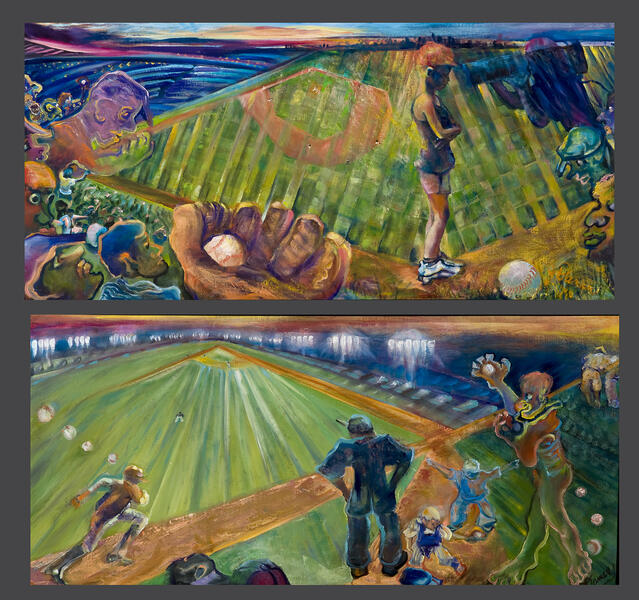 Boyhood Coat of Mail & Reborn Old Man
Boyhood Coat of Mail & Reborn Old ManThe two 2015 companion paintings, oil on linen, 17.5 x 38" are responses to Ragain's "An Old Man Lies Down With the Lion" It is a story of transformation. The last verse, "Thou shall lie down with the lion. Thou shall be reborn as an old man." I imagined a boy, embarrassed, everyone is glaring at him. Perhaps he missed the big catch or struck out. He is humiliated and alone. That boy becomes an old man, he imagines comforting another boy or catching that hit.
-
An Old Man Lies Down With the Lion read by John Wright
"An Old Man Lies Down With the Lion" a poem written by Maj Ragain and read by John Wright reminded me of the bitterness children can feel when they feel they haven't performed. Bitterness lodges when a kid can't ever please. The failed baseball play was my entry point.
-
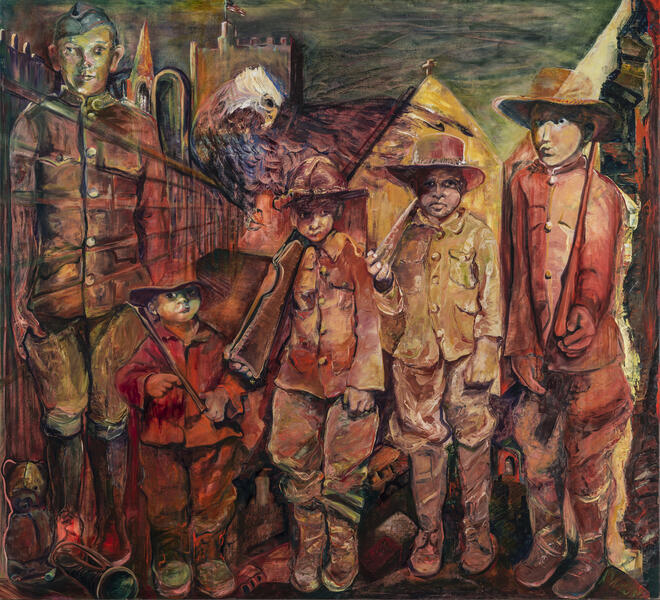 Dulce et Decorum est Pro Patria Mori
Dulce et Decorum est Pro Patria MoriDolce et Decorum est, Pro Patria Mori (71 x 78", oil on linen, 2014 & 2004) is a line from the Roman lyrical poet Horace’s Odes (III.2.13). The line can be roughly translated into English as: “It is sweet and right to die for your country.” Wilfred Edward Salter Owen (1893-1918) used Horace’s line in his famous WWI poem of the same title. The last line forewarns the impressible boy the Dolce Et Decorum Est is the old lie.
-
Dolce Et Decorum Est read by James Scofield
Scofield has taught Wilfred Owen's powerful poem and the pain and fear is loud and clear with his reading.
-
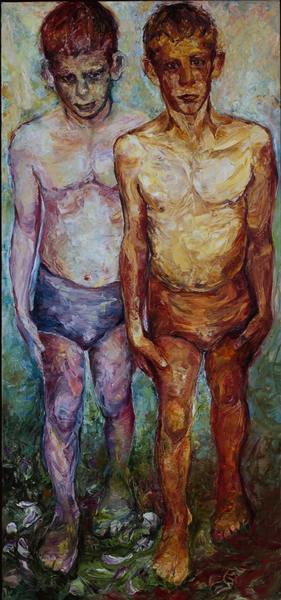 My Two Selves
My Two Selves60 x 28", oil on canvas, 2000
The model's pose refers to ancient Greek kouros. It addresses the ambivalent identity of male youths caught between their most elemental needs for security, love and tenderness, and their fear of being labeled effeminate. American youths are not encouraged to live with balance and beauty and therefore my kouros are clothed. Their sexual nature is conflicted. I represented the conflict with two figures, one with his pectoral muscles strong and sure, the palette knife sweeping across his chest. The other molded with a more tentative blade, his glance reticent and his colors softer and more muted.
-
He Rushed Forth Without Weapons read by Archer Senft
Soft and crashing waves introduce the reading of Maj Ragain's response poem "He Rushed Forth Without Weapons" to my painting, "My Two Selves." The qualities of water: life giving, tranquil, crashing and dangerous express perfectly the dichotomy seen in "My Two Selves." Senft's deliberate reading seems to express a hesitancy but someday, he will be one.
Visions Verses Voices - An Immersive Installation: Memories & Dreams 2001 - 2014
Maj Ragain penned all the poems in this section although, many were his response verses, after he saw my paintings. Maj and I met while we were resident fellows at the Fine Arts Work Center in Provincetown, MA. While there, we found that our art dealt with truths about our experiences as parents revealing our hopes and fancies, foibles and failures. Whimsical and mysterious creatures, animals, toys and hidden faces, surround the boys and girls within my painted fields. Some children float on a whale, or stand on an oyster shell, a Madonna or, the shield of a blue bathing suite protect the young ones. Others are threatened by an ominous wall face or volcanic eruption. Perhaps they express Maj and my anxieties about our children' adolescence or, our hopes for their future.
References:
Maj Ragain, (1948-2018), Clouds Pile Up in the North: New & Selected Poems
Damen, Jessica & Ragain, Maj, Vision to Verse-Verse to Vision: A Visual and Poetic Dialogue, exhibition catalog, June 15-September 4, 2004
Damen, Jessica & Ragain, Maj, Home To Sargasso Sea-A Long Journey of Loving Collaboration, exhibition catalog, June 1-July 14, 2018, KSU Downtown Gallery, Kent OH, Kent State University School of Art Collection and Galleries and the Wick Poetry Center with support from the Ohio Arts Council.
Visions Verses Voices is an on-going immersive exhibition of paintings accompanied with poems that expands my love of verse in communication with my visual imagery. As presented at the Delaplaine Art Center in Frederick, MD, twenty-five poems were featured read by various people: professionals such as, Tom Hall, program host, WYPR, singers, amateur actors and just interested individuals who put in the time to be coached. Their readings were played from speakers in continuous loops, strategically placed throughout the gallery. All of the readers share an interest, even love, for the verse they read, which, I believe is conveyed through their unique voices. My purpose in creating this immersive exhibition is to demonstrate the interrelationship of verse and painting by encouraging the viewer/listener to experience the voices of the readers while viewing my paintings. The simultaneous experience makes for an enhanced appreciation of the poems and paintings.
The various readers’ tempos, cadences and unique rhythms add the visual experience by challenging the viewer to see relationships and dissonance. The poetry readers selected poems that resonated with them so that some poems are read by multiple readers. Poems can be long stories conveying a sense of place and time with anecdotes. Others are shorter imagist works.
Damen endeavored to interpret expressively the gestalt of a poem with color, scale, and images creating her personal interpretations. These soundtracks are artworks too. Music or other sounds are blended with the verses introducing a mood of harmony or contrast with the verse or vision. Additionally, the viewer/listener is able to access each audio from the exhibition's website: https://visionsversesvoices.com/
The Painting image is followed by the recited poem and soundscapes.
Jessica Damen thanks Lindsay Bottos, multimedia artist, for her expertise in collaborating on the production of the soundtracks.
-
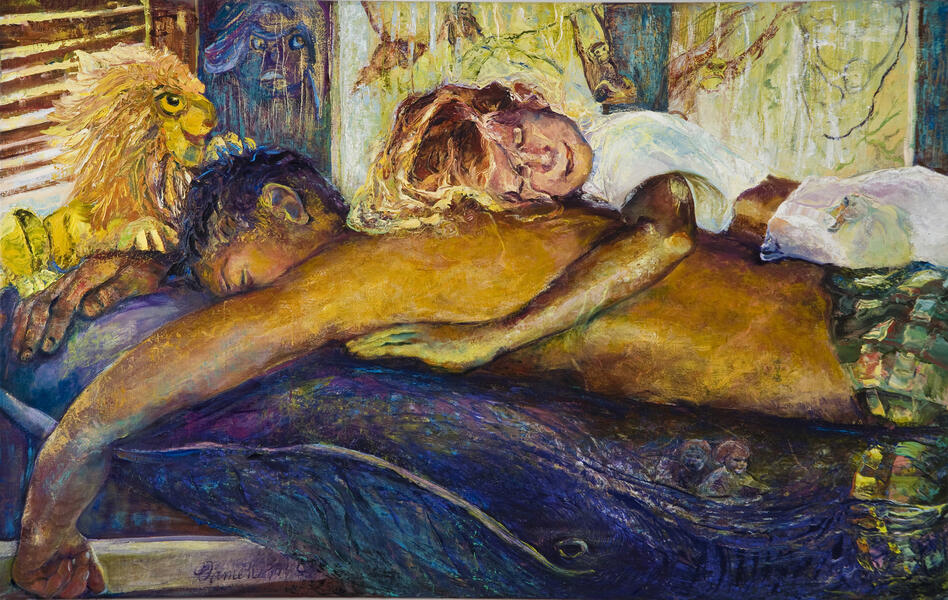 Jo, Jon Floating on Jonah's Whale
Jo, Jon Floating on Jonah's WhaleJo, Jon Floating on Jonah's Whale (38 x 60", oil on canvas, 2003 & 2014), was first painted early summer 2003 while Maj and I, took advantage of the interim session for former fellows. He saw me struggling with the lower right corner close to the whale eye. Often he just sat and observed while I painted. Oddly, I did not feel self-conscious. I told him that the painting was inspired by a photo of my two children taking an afternoon nap. But, of course, the story is so much more. I frequently return to my paintings when I want to improve an area. In 2014, I reworked Jon's hand and arm. Ragain's responsive poem is "Contents of the Whale’s Belly, Grounded Off Race Point, Provincetown, Cape Cod, June 2003"
-
Contents of the Whale's belly read by Louise P Senft
"Contents of the Whale's Belly, Grounded Off Race Point, Provincetown, Cape Cod, June 2003" by Maj Ragain is read by Louise Phipps Senft. The reading of this long poem referencing the biblical story of Jonah and the Whale is introduced with whale sounds and soft waves. Is is a perfect summer afternoon. Maj and Louise take on a wild ride to the abyss and back again.
-
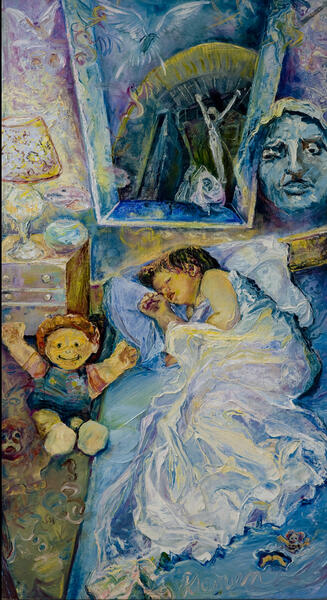 Now I Lay Me Down To Sleep
Now I Lay Me Down To SleepNow I Lay Me Down To Sleep (62 x 34", oil on canvas 2003) are lines from an old bedtime prayer. I remember reciting it when I was a child. The skewed perspective reflects a child’s fear that the sky is falling through the skylight. The environment is filled with Christian and contemporary imagery. Goya’s witches cackle and sharks swim in the fish bowl. The pained Madonna glances toward the sleeping child. My friend and collaborating poet, Maj Ragain wrote “A Dreamer Sails into the Land of Nod” in response to this painting. I am most grateful for his insightful verse. "Sleep is a small death, the child Rebekah a fish suspended in a deep, shadowed pool..."
-
A Dreamer Sails Into the Land of Nod read by Louise Senft
Louise Phipps Senft read Maj Ragain's responsive poem, entitled "A Dreamer Sails Into the Land of Nod." It is introduced with a mobile's playing of Brahm's Lullabye. Senft's reading is energetic. She captures the environment of playfulness, as well as, dread. After some twist and turns with philosophical reflection, her voice softens. She soothes the little pilgrim.
-
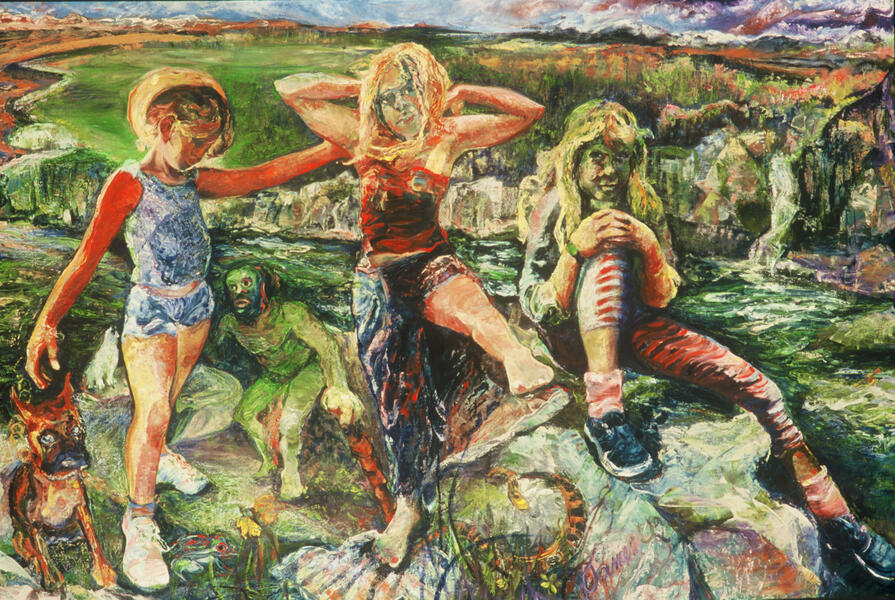 Quick River in a Green Time
Quick River in a Green Time50 x 74.5", oil on canvas, 2002
A response painting to Maj Ragain’s poem, “For My Daughter Meg, Graduating From Kent Roosevelt High School” also loosely references Sandro Botticelli’s “The Birth of Venus”. This “goddess” is a come hither adolescent on top of an upside down seashell. I imagine my goddess evolving from the green sinewy girl and more charming modern girl wearing sport gear. The environment is both verdant and perilous, a creepy Rumpelstiltskin imp lurks and they are surrounded by unnavigable, fast white rapids.
-
For My Daughter Me Graduating...read by Rufus Lusk III
Reader is Rufus Lusk, a retired businessman and clergyman. The introductory sound of a rushing stream sound implies the rapidity of change and a child's growth. Before one knows it, the girl is a woman. But the distance can be a turbulent ride. Rufus chose this poem because he is a father of two girls.
-
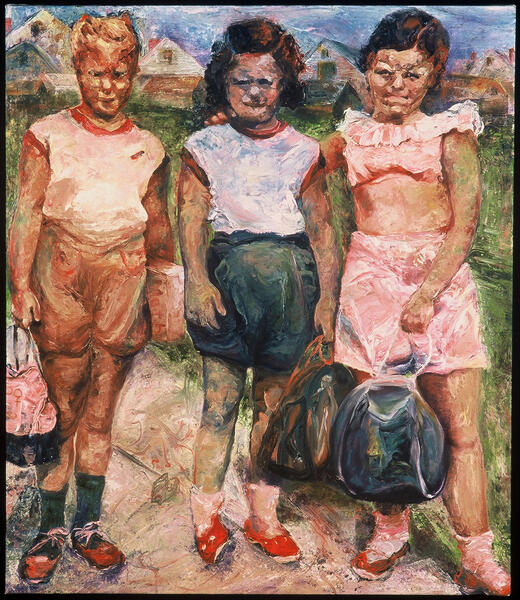 Say Cheese
Say Cheese58 x 50", oil on canvas, 2000
The painting is nostalgic but with a bit of unease. These girls are not happy, the title, “Say Cheese” is an ironic mention. Maj Ragain’s response poem, “What the Dead Remember” takes a darker turn. He imagines the girl with no name. She is dead and forgotten. The suburban idyllic atmosphere is pierced with a dose of mortal reality. Can the listeners of the poem hear the dissonance between the saccharin colors and foreboding message?
-
Wha the Dead Remember read by Jill Goodman
"What the Dead Remember" was read by Jill Goodman, an educator who was coached to read the poem. She begins her clear reading with a jaunty rhythm and then slows as the sad, forgotten girl is revealed. The reading, which is introduced with the sounds of children playing, juxtaposes the ironic sense of the painting with the more somber feeling of the poem.
-
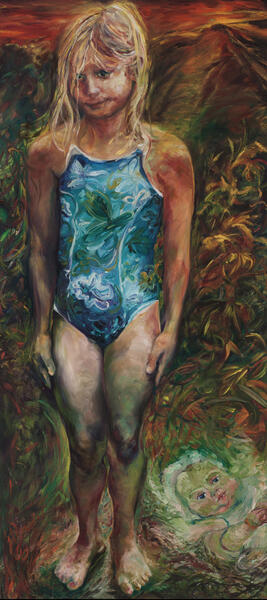 My Private Garden
My Private GardenMy youngest daughter modeled for My Private Garden (62 x 28", oil on canvas, 2000) one cool early autumn day. Her posture and form were as perfect as the korai she was asked to mimic. Yet, she retained her individuality and the strength of a modern girl. While painting her from the photographs taken that day, I envisioned her bathing suit, as a shield, protecting her from the volcanic eruption of emotions I knew would erupt in a few years. She was transitioning from the impish baby (compliments of Van Gogh) to a girl on the cusp of adolescence.
-
Holding & Being Held- read by Olivia Hollender
Olivia Hollander's reading of Maj Ragain's poem, "Holding and Being Held by the Breath: A Solitude" emphasizes that the girl is trapped. Olivia reads "...landlocked, heavy heeled, hands at her sides. The dirt beneath her swims into cloud. She cannot leave, hostage to the planter’s trowel " carefully, puncturing each word.
Visions Verses Voices - An Immersive Installation: Solace & Transcendence - 2014 - 2021
Beginning with artworks inspired by Ragain poems, "Be Secret & Exult” and “You Will Need the Wings of a Crane” my heavily impasto paintings confronted two main themes: fear of death and liberation from self imposed limitations. These artworks were reworked in January 2021. Other Ragain poems included in this portfolio describe nostalgic remembrances that taught important lessons. Maj even introduced us to a ghost who reminds us that, after the grave, still, we wish for our voices to be heard. The one Lewis poem posted here, “Winter Garden” is a sensual and rhythmic verse, the dreamed garden of safety for “Child, dream of a pomegranate tree - Weighted with ruby, showered with gold,…” I was drawn to Lewis’ poem for its vow, “To ward and to cherish even as now, Now that you sleep you joy to replenish, Each branch, each varied lifting bough, That not a leaf in your garden perish.” I well remember that wish of perfect garden of protection for my children.
References:
Maj Ragain. Burley One Dark Sucker Fired: Collected Poems. Working Lives Series. Bottom Dog Press. Huron, OH, p.15, p.48, p.59
Janet Lewis. Poems Old and New 1918-1978. Swallow Press, Ohio University Press, Chicago, IL 1982 p. 72
Visions Verses Voices is an on-going immersive exhibition of paintings accompanied with poems that expands my love of verse in communication with my visual imagery. As presented at the Delaplaine Art Center in Frederick, MD, twenty-five poems were featured read by various people: professionals such as, Tom Hall, program host, WYPR, singers, amateur actors and just interested individuals who put in the time to be coached. Their readings were played from speakers in continuous loops, strategically placed throughout the gallery. All of the readers share an interest, even love, for the verse they read, which, I believe is conveyed through their unique voices. My purpose in creating this immersive exhibition is to demonstrate the interrelationship of verse and painting by encouraging the viewer/listener to experience the voices of the readers while viewing my paintings. The simultaneous experience makes for an enhanced appreciation of the poems and paintings.
The various readers’ tempos, cadences and unique rhythms add the visual experience by challenging the viewer to see relationships and dissonance. The poetry readers selected poems that resonated with them so that some poems are read by multiple readers. Poems can be long stories conveying a sense of place and time with anecdotes. Others are shorter imagist works.
Damen endeavored to interpret expressively the gestalt of a poem with color, scale, and images creating her personal interpretations. These soundtracks are artworks too. Music or other sounds are blended with the verses introducing a mood of harmony or contrast with the verse or vision. Additionally, the viewer/listener is able to access each audio from the exhibition's website: https://visionsversesvoices.com/
Jessica Damen thanks Lindsay Bottos, multimedia artist, for her expertise in collaborating on the production of the soundtracks.
-
 Lalla Finds Her Wings
Lalla Finds Her WingsLalla Finds Her Wings (88 x 36 x 3", oil on canvas, 2021 & 2004), was reworked in '21 after the long confinement of the Pandemic's lock down. Indeed, I felt liberated. This painting is inspired by another Ragain poem, "You Will Need the Wings of a Crane."
I was drawn to his poem because of the story of the poet Lalla. "In bad weather, she was naked. She lived in her soul. She wanted paradise. What husband could give her that." This painting expresses a body partially landlocked. She is ready to fly away.
-
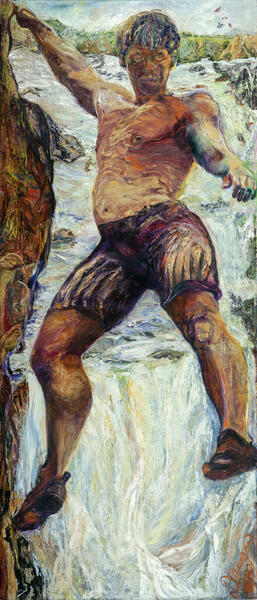 Be Secret & Exult
Be Secret & ExultBe Secret & Exult (88 x 36 x 3", oil on canvas, 2021 & 2004) was reworked from my 2004 version. It is a painting inspired by a Ragain poem of the same title. This heavily impasto artwork took a lot of strength. I loaded my palette knife with thick oil paint varied in tone and hue and then used my entire body moving strokes to make pectoral muscles, strained gluts and calf muscles. The climber's nearly impossible finger and toe holds suspended over turbulent currents was the image of death defying strength. Hubris or courage, the painting confronts know and unknown dangers - our fear of death.
-
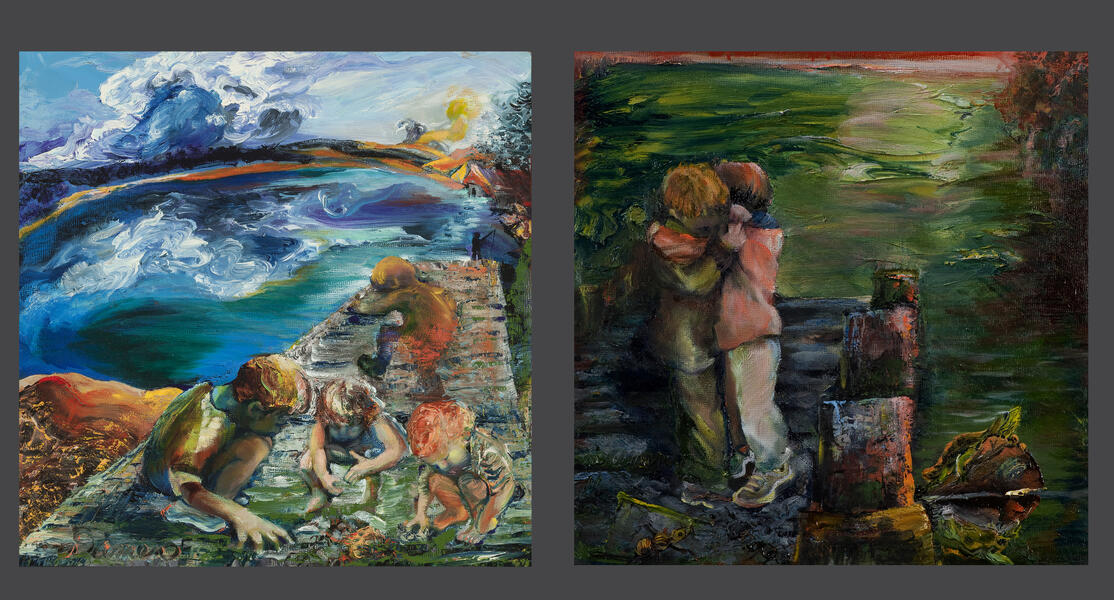 Worker Ants & Demise of Benny the Brave
Worker Ants & Demise of Benny the BraveEach 12 x 12", oil on panel, 2016
The two 12x12" oils on wood panels are companion paintings which respond to Ragain's poem "Clouds Pile Up North." This long, narrative takes the reader from a quaint summer scene and exposes a raw anger in a child. My approach was to identify with the children, their inquisitiveness, fantastical clouds and a more distant jumping child. The next panel of murky green offers comfort and forgiveness.
-
Clouds Pile Up North read by Tom Hall
Maj Ragain's poem "Clouds Pile Up North" begins with an idyllic setting. The old man recounts his playfulness with the local children. Tom Hall, (radio program host, WYPR) uses his melodious voice to bring us to that time. We see and hear each child. They are not easily fooled. The mood changes as does the readers voice. There is tension and a warning given to the youngsters.
-
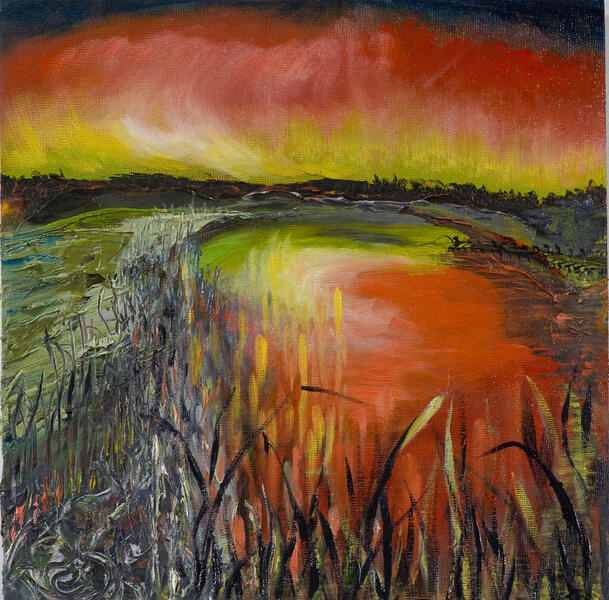 A Fisherman's Aurora Borealis
A Fisherman's Aurora Borealis12 x 12", oil on panel, 2016
Maj saw my painting and it immediately reminded him of his poem, "A Luminous Phenomenon". My painting imagines Maj as a Taoist fisherman, a speck in the universe, under the Northern Lights. After a doctors visit where "She knows I am waist deep in muddy water." Maj remembers the awe he felt under the Northern Lights as he faces his diminishing health.
-
A Luminous Phenomenon read by Tom Hall
“A Luminous Phenomenon” is read by Tom Hall (Program host, WYPR). We enter this poem through a doctors office. Maj's health is not good and "She (the doctor) knows I am waist deep in muddy water." Then we switch to the cosmic sphere. He recalls his father’s love. The Northern Lights, an amazing phenomenon is shown to the sleeping child. He is part of the eternal.
-
 Little Sister
Little Sister12 x 12", oil on panel, 2016
This painting is about the ghost the poet recalls in his poem "Winter for Skylark and Little Sister." I was drawn to the poem even though I found it elusive. The girl ghost wanted to be heard, she had so much more to say. Perhaps Maj is also wondering how he will be heard after the grave?
-
Winter for Skylark & Little Sister read by Steve Heine
Steve Heine, the reader, is a father and a bank president. Recorded during a very busy day, he nonetheless read with sympathy for the speechless.
-
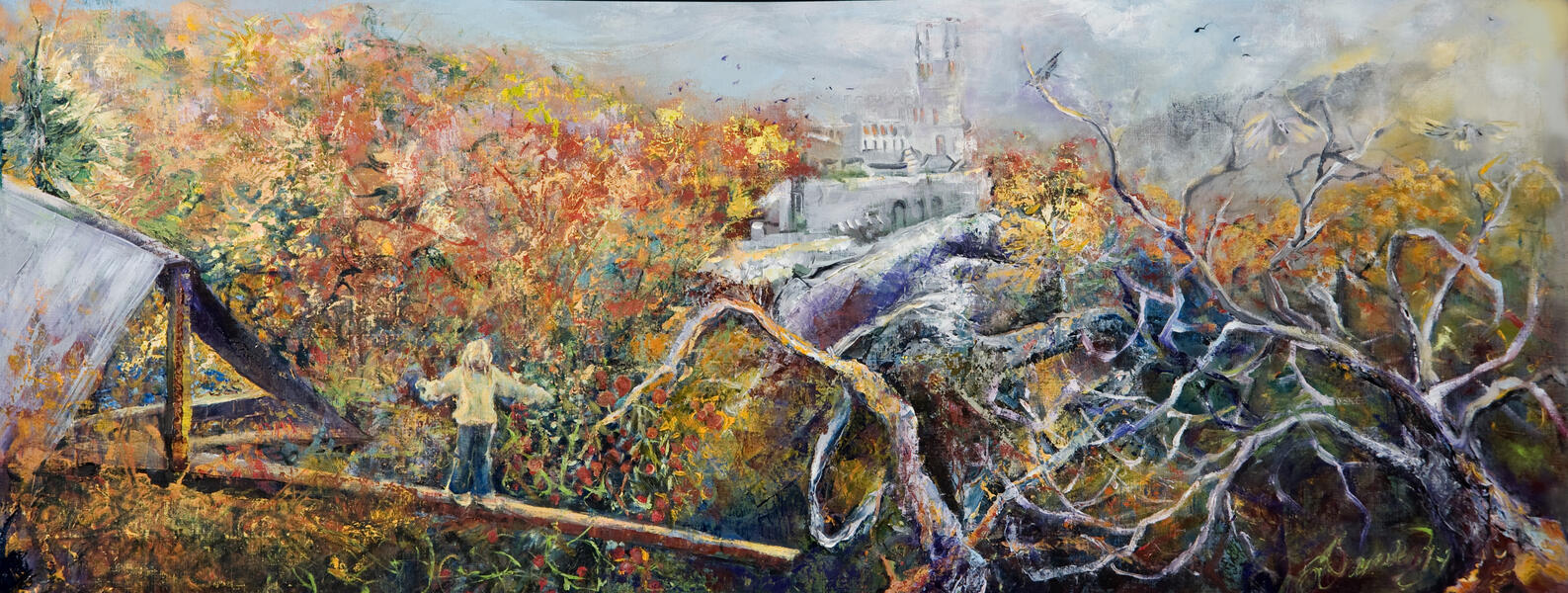 Wishful Vow
Wishful Vow18 x 46", oil on linen, 2014
Janet Lewis' poem "Winter Garden" inspired this fantastic landscape and a child's perilous walk along an unsecured plank. Lewis recalls a child in a beautiful garden with calendulas, pomegranate tree and twisted vines. Then, like so many fairy princesses, she pricks her finger, but is not cursed. Instead Lewis makes a vow, "Now that you sleep your joy to replenish, Each branch, each varied lifting bough, That not a leaf in your garden perish." It is a “Wishful Vow”.
-
Winter Garden read by Olivia Hollender
Leda, the Swan and the Original Rape Myth '03-'16
The later patriarchal Greek myth derives from an even more ancient love chase myth. Prior to patriarchal religions, the goddess, known as Lepta or Lento, pursues a god until she devours him and a swan takes him north to a final resting place. Ironically, the ancient Greeks changed the swan from the symbol of the goddess’ triumph to her downfall and rape. (1) The Hellenistic version has Zeus disguised as a swan, so that he can rape the beautiful Leda without upsetting his goddess wife, Hera.
Visual representations of Leda’s rape from the early Renaissance through the nineteenth century show a compliant, soft and willing Leda. To this day complicity is a frequent rationalization for rape. This series is painted from a Leda’s point of view engaging the viewer into imagined emotional responses. Below is Maj Ragain's response poem to my painting, "Leda and the Angry Swan."
Leda's Voice, Under Sky, Over Water (2)
I lie in the wreckage of my longing
which called him down to me.
I remember myself before Zeus settled
over me, in the guise of a swan,
downy chest against my nipples.
That world is gone.
I have been opened, my thighs spread
by wings beating all around me,
churning my blood into fever.
I am slathered with his god seed,
planted on this tortoise shell bed,
pinned down by clawed feet on bare skin.
His wings, spread across the sky,
eclipse the sun beneath which
all things are his domain.
I was mine. Now, I am his.
I will scissor my hair to the scalp
so he will not desire me if he returns.
Hera, his wife, has found us.
He rises in anger at her meddling.
I am sore.
The milky way swims in my belly.
Wherever you go, my empty eye follows.
- Maj Ragain
Jan. 5, 2004
The above Ragain poem was written after he saw my painting, Leda and the Angry Swan. The verse is his reaction to my painting. The opening of his poem, "I lie in the wreckage of my longing/ which called him down to me" angered me. Because in my opinion, the lines feed directly into one of the rape's myths, that is, the victim asks for it. I decided to do another painting, a prequel entitled, What's This in response to those lines. The other paintings in this series lead the viewer through a process of transcendence. By the end Leda is dancing goddess, her arm raised, as if reaching toward heaven.
(1) Graves, Robert. The Greek Myths:Volume I, London, England: Peguin Books, 1960
(2) Maj Ragain, Poet & Jessica Damen, Painter, "Vision to Verse - Verse to Vision : A Visual and Poetic Dialogue, Verde Gallery: Champaign, IL, 2004
http://bmoreart.com/2016/08/studio-visit-jessica-damen.html
-
 Leda & the Angry Swan 72x102" OC '03The historical images of the Leda myth, whether pruriently imagined or disguised as “divine” sensual rapture are from a male perspective. My goal when painting this Leda is to make Leda’s eye the focus of the painting. The viewer cannot escape her gaze, the window to her soul. She is overpowered, but not subdued. The Swan-Zeus is not a loving “divine spirit” but rather, a territorial, aggressive being.
Leda & the Angry Swan 72x102" OC '03The historical images of the Leda myth, whether pruriently imagined or disguised as “divine” sensual rapture are from a male perspective. My goal when painting this Leda is to make Leda’s eye the focus of the painting. The viewer cannot escape her gaze, the window to her soul. She is overpowered, but not subdued. The Swan-Zeus is not a loving “divine spirit” but rather, a territorial, aggressive being. -
Ragain's poem Leda's Voice read by Lindsay Bottos & background soundsLindsay Bottos, read Ragain's poem "Leda's Voice, Under Sky, Over Water" after my installation of "Visions Verses Voices" closed. Even though, "Leda and The Angry Swan" wasn't included in the original Delaplaine exhibition this painting and Ragian's responsive poem and my painting "What's This" are nevertheless, integral to "Visions Verses Voices" goals. Lindsay's reading is made more powerful by her soft, timorous voice subtly conveys Leda's pain.
-
 What's This? 60x79" OL, '16"What's This?" describes the moment just before Leda's violation. It is a response to Ragain's opening lines: " I lie in the wreckage of my longing which called him down to me. I remember myself before Zeus settled over me,..... That world is gone." As a prequel my point is to create ambiguity. What longing? Why the piglet and nest? What does her expression reveal to you?
What's This? 60x79" OL, '16"What's This?" describes the moment just before Leda's violation. It is a response to Ragain's opening lines: " I lie in the wreckage of my longing which called him down to me. I remember myself before Zeus settled over me,..... That world is gone." As a prequel my point is to create ambiguity. What longing? Why the piglet and nest? What does her expression reveal to you? -
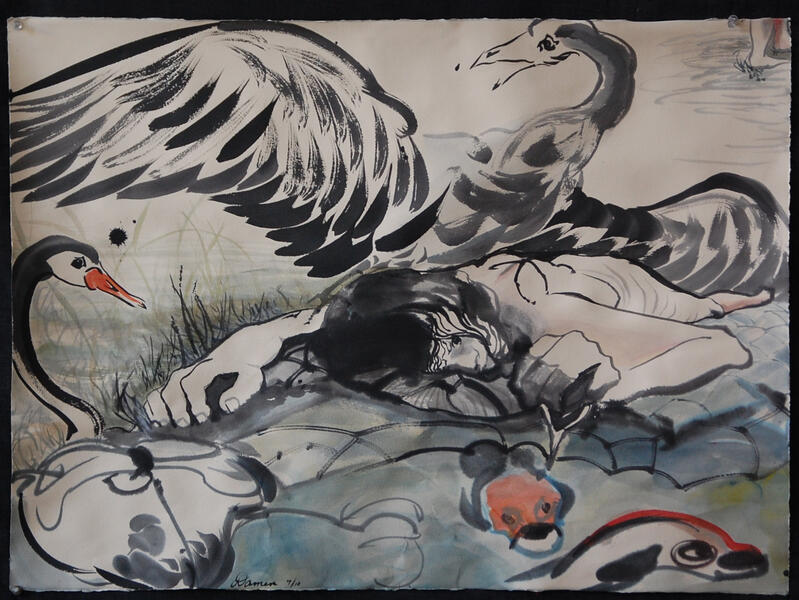 She Walked Away 22x30" ink,wc/paper '10"She Walked Away" imagines her dissociation from the physical and emotional trauma of rape.
She Walked Away 22x30" ink,wc/paper '10"She Walked Away" imagines her dissociation from the physical and emotional trauma of rape. -
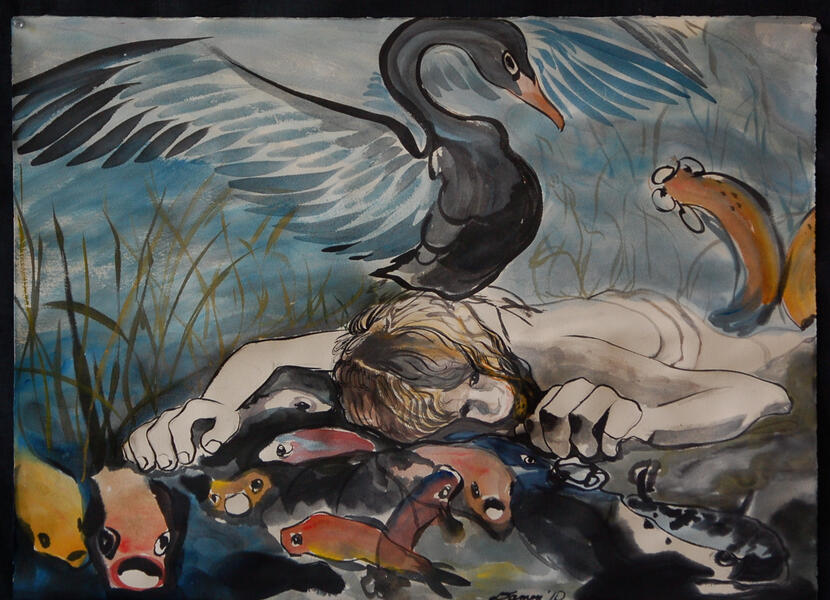 Remember Myself, 22x30" ink,WC/paper, 2010Ragain opening phrase recognizes that after rape one is never the same. Leda is gone and can only remember her former self. "I remember myself before Zeus settled over me, in the guise of a swan, downy chest against my nipples. That world is gone."
Remember Myself, 22x30" ink,WC/paper, 2010Ragain opening phrase recognizes that after rape one is never the same. Leda is gone and can only remember her former self. "I remember myself before Zeus settled over me, in the guise of a swan, downy chest against my nipples. That world is gone." -
 Leda's Revenge 11x14" OP '14"Leda’s Revenge" is a revenge fantasy for every woman who has ever wanted to kill her rapist.
Leda's Revenge 11x14" OP '14"Leda’s Revenge" is a revenge fantasy for every woman who has ever wanted to kill her rapist. -
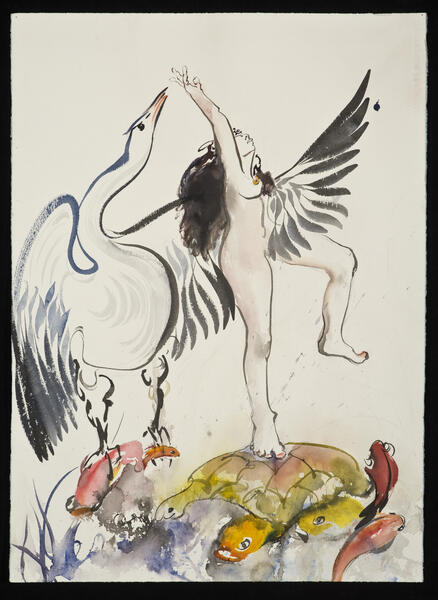 Leda Dancing I 30x22" ink,wc/paper '12Leda Dancing I and II envisions a transcendent goddess, her finger pointed toward heaven.
Leda Dancing I 30x22" ink,wc/paper '12Leda Dancing I and II envisions a transcendent goddess, her finger pointed toward heaven. -
 Leda Dancing I 30x22" ink/wc/paper '12Leda Dancing I and II envisions a transcendent goddess, her finger pointed toward heaven.
Leda Dancing I 30x22" ink/wc/paper '12Leda Dancing I and II envisions a transcendent goddess, her finger pointed toward heaven. -
 What's This III 20.5x17" ink/wc/paper '16“What’s This III” an ink brush painting on Hsuan paper is part of a series developed after I completed the oil, “What’sThis?” My use of Chinese ink and brush encourage me to paint Leda’s different expressions. Here is the swan overpowering her.
What's This III 20.5x17" ink/wc/paper '16“What’s This III” an ink brush painting on Hsuan paper is part of a series developed after I completed the oil, “What’sThis?” My use of Chinese ink and brush encourage me to paint Leda’s different expressions. Here is the swan overpowering her. -
 What's This V, 25x19" ink/wc/paper '16“What’s This V” has a lighter brush and the swan’s movement is freer. Leda’s expression is unique with each version.
What's This V, 25x19" ink/wc/paper '16“What’s This V” has a lighter brush and the swan’s movement is freer. Leda’s expression is unique with each version.
The Other Story- Ariadne/ Heroine '06-'16
-
 Ariadne's Triumph 21.5x28.75" OL '16“Ariadne’s Triumph” was completed during 2016. It brings this personal myth narrative to conclusion. The painting field is layered and muted. Within the field are the personages of Ariadne: wrestlers, brave and enduring, muscular women. She is the heroine, who completes her quest by killing the Minotaur.
Ariadne's Triumph 21.5x28.75" OL '16“Ariadne’s Triumph” was completed during 2016. It brings this personal myth narrative to conclusion. The painting field is layered and muted. Within the field are the personages of Ariadne: wrestlers, brave and enduring, muscular women. She is the heroine, who completes her quest by killing the Minotaur. -
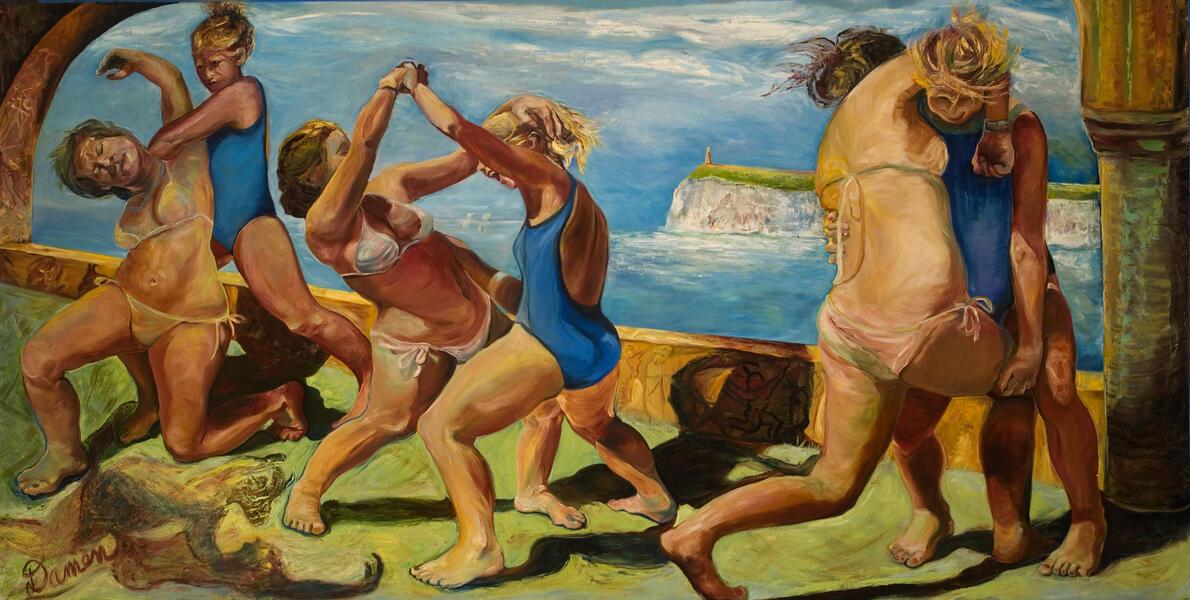 Epic Wrestlers 63x127" OC '09My re-envisioning of this myth sees Ariadne as neither Bacchus’ wife nor the abandoned suicide. She and her counterpart are muscular, wrestling with one another and self. This epic-wrestling match is a quest for life and a struggle for self-identity.
Epic Wrestlers 63x127" OC '09My re-envisioning of this myth sees Ariadne as neither Bacchus’ wife nor the abandoned suicide. She and her counterpart are muscular, wrestling with one another and self. This epic-wrestling match is a quest for life and a struggle for self-identity. -
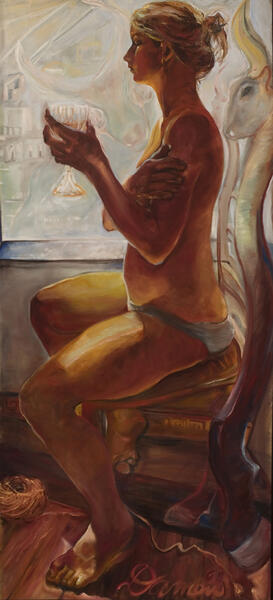 Hold on Tight 62x28" OL '08“Hold on Tight” is Ariadne before she decides her path. Back lit with stark, bright imagery, her facial profile is elegant and regal. Her hair is built with colorful, twisting palette knife marks. She sits within the belly of the bull. Her throne is both her power and nemesis. At her feet is the red thread, Theseus' lifeline and her fate. This Ariadne has muscular legs. She is an athlete, although she holds onto herself because it takes courage to defy. She is the author of her fate. I image her taking a sip of wine before her battle.
Hold on Tight 62x28" OL '08“Hold on Tight” is Ariadne before she decides her path. Back lit with stark, bright imagery, her facial profile is elegant and regal. Her hair is built with colorful, twisting palette knife marks. She sits within the belly of the bull. Her throne is both her power and nemesis. At her feet is the red thread, Theseus' lifeline and her fate. This Ariadne has muscular legs. She is an athlete, although she holds onto herself because it takes courage to defy. She is the author of her fate. I image her taking a sip of wine before her battle. -
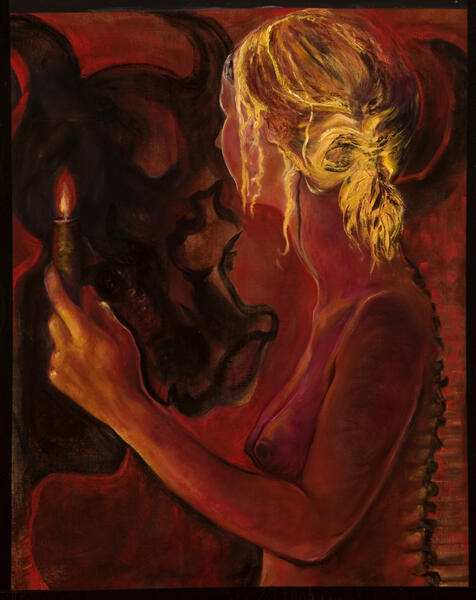 Shadows 37x29" OL '08Picasso’s “Minotauromachy” inspired “Shadows”. Whereas Picasso’s print has a girl holding the lit candle, I have a young woman, Ariadne, her spine exposed, is bathed in red and black shadows. The woman is complex and full fleshed. A sense of quiet unease permeates the atmosphere. While the monster “other” lurks, it is the mature woman who holds the focal point.
Shadows 37x29" OL '08Picasso’s “Minotauromachy” inspired “Shadows”. Whereas Picasso’s print has a girl holding the lit candle, I have a young woman, Ariadne, her spine exposed, is bathed in red and black shadows. The woman is complex and full fleshed. A sense of quiet unease permeates the atmosphere. While the monster “other” lurks, it is the mature woman who holds the focal point. -
 Jumping Bulls 52x77" OL 08The Surrealists concentrated on the dual nature of man and beast as personified in the Minotaur. But “Jumping Bulls” directs the viewer’s attention to the relationship of Ariadne and her girlfriends. It is a “what if” story, while recognizing that The Bull is a presence, this story is from the woman’s perspective. In the wall environment are images from Minoan wall mosaics of bare breasted women jumping bulls. Their near nakedness is not for the male gaze. This painting is a counterpoint to hyper-sexualized or helpless images of women.
Jumping Bulls 52x77" OL 08The Surrealists concentrated on the dual nature of man and beast as personified in the Minotaur. But “Jumping Bulls” directs the viewer’s attention to the relationship of Ariadne and her girlfriends. It is a “what if” story, while recognizing that The Bull is a presence, this story is from the woman’s perspective. In the wall environment are images from Minoan wall mosaics of bare breasted women jumping bulls. Their near nakedness is not for the male gaze. This painting is a counterpoint to hyper-sexualized or helpless images of women. -
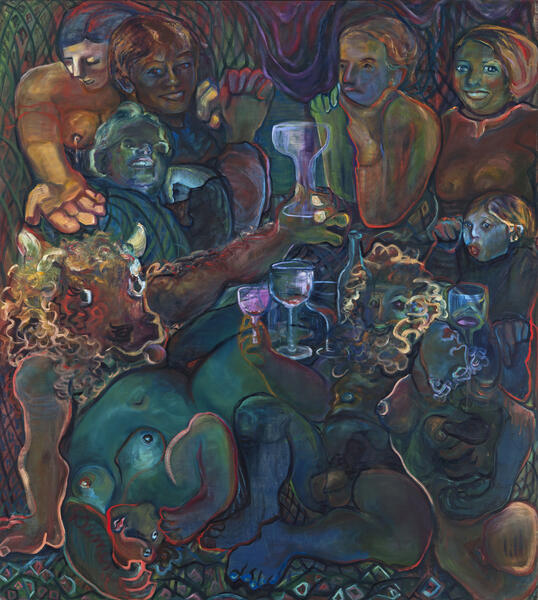 Strange Guests 70x62" OL '07“Strange Guests” integrates one of Picasso’s bacchanian prints and two of his early 20th century somber women. I wove into this narrative my own family. The oil painting presents a picture of complementarities in color, line and form. The Minotaur, the projection of human’s dual nature, is also a bit of a fluff with his long eyelashes.
Strange Guests 70x62" OL '07“Strange Guests” integrates one of Picasso’s bacchanian prints and two of his early 20th century somber women. I wove into this narrative my own family. The oil painting presents a picture of complementarities in color, line and form. The Minotaur, the projection of human’s dual nature, is also a bit of a fluff with his long eyelashes. -
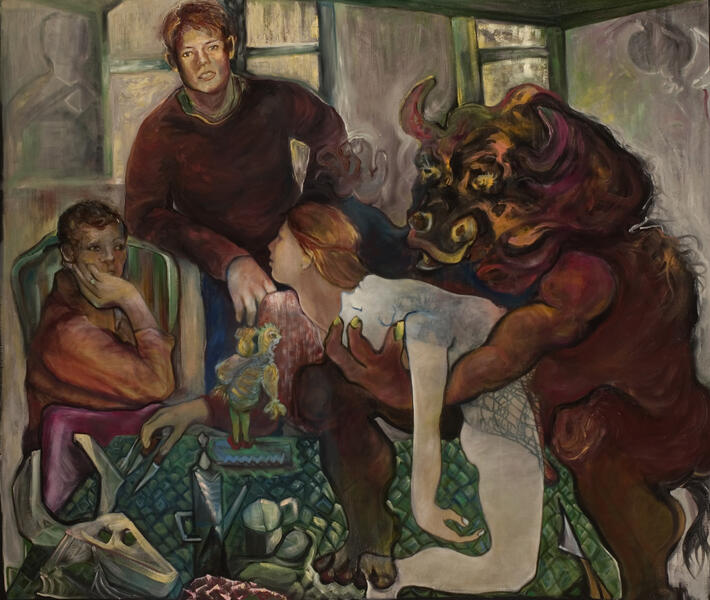 Who Opened the Window 65x77" OL '08"Who Opened the Window" places Picasso’s depiction of libidinal and aggressive energies within the context of a family gathering. Here the grotesque double is an intruder at the dinner table and the bacchanian feast is integral to the family’s posturing.
Who Opened the Window 65x77" OL '08"Who Opened the Window" places Picasso’s depiction of libidinal and aggressive energies within the context of a family gathering. Here the grotesque double is an intruder at the dinner table and the bacchanian feast is integral to the family’s posturing. -
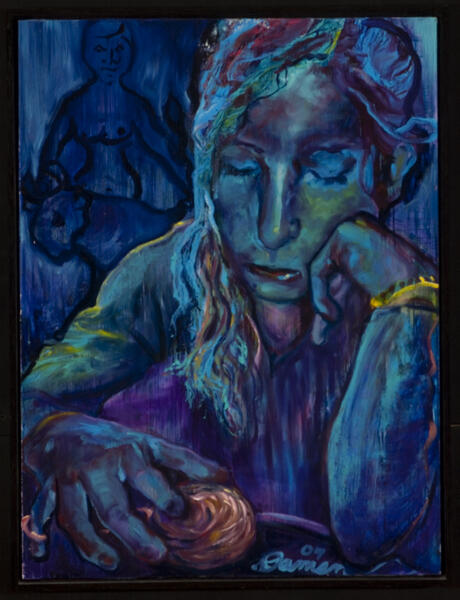 Conundrum 24x18" OP '09"Conundrum” is a simple portrait of a pensive girl.
Conundrum 24x18" OP '09"Conundrum” is a simple portrait of a pensive girl. -
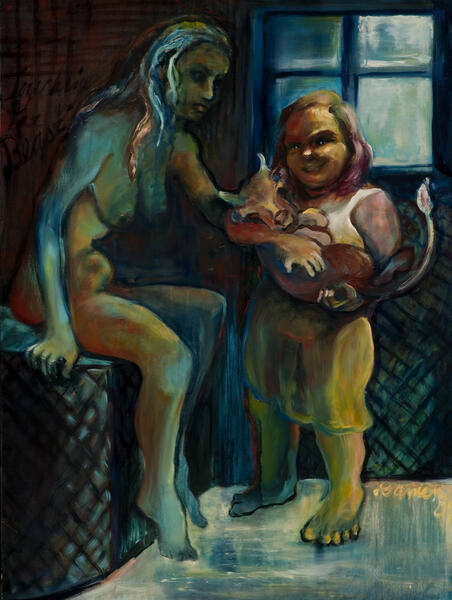 Touching the Beast 24x18" OP '09Once again referencing a print by Picasso, I envision the girl heroine embracing her beast.
Touching the Beast 24x18" OP '09Once again referencing a print by Picasso, I envision the girl heroine embracing her beast. -
 Punch, 16x20" OP '09Ariadne punches her way out of her conundrum.
Punch, 16x20" OP '09Ariadne punches her way out of her conundrum.
"The Past is never dead. It's not even past." Wm. Faulkner 2000 - 2016
The photograph, the modern person's means to immortal portrayal, is often the source for my work. This portfolio ends with “The Long Immortal Day ”, a portrait of my husband’s daughter, Adriana, who was tragically killed in a car accident. Her photographs, my husband and close family members’ memories are all that remain of her. We soothe mortality’s erasure with the consolation that a life fully lived is sufficient. But when death steals a child’s life, how does one find comfort? A parent, Vincenzo Gulotta, whose son was dying of leukemia, sought comfort from Janet Lewis with a poem request. I happened upon Lewis’ response poem, “For the Father of Sandro Gulotta” before I attempted Adriana’s memorial portrait. I needed the poet’s verse so I could reenter that time of irreplaceable lose. The poem crystalizes Lewis’ preoccupations with time, death and birth using the metaphor of the day lily to capture the simplicity of the child’s life and the recognition that the day lily’s purpose is completed within a day. And while the day lily serves as a “paradigm for the formal organization of time: days, seasons and years” (1)it also is a living thing that;“…drank the sunlit air.
In one long day
All that it needed to do in this world
It did,…” (2)
Keeping with the theme that, "The Past is never dead. It's not even past." (Wm. Faulkner), I also include paintings addressing contemporary issues: the long history of American racism, the indoctrinating a soldier identity in children, the facade of the "perfect" suburban white American family.
Early in this series my own children are models and they inspired my visual wanderings. Other times, I use found photographs. As the series progresses they move from being my child to, Child, a universal source for my bemused wonderment. She is a whisperer or a seer. Her role and demeanor changes as my interest lead me to and from fairytales, myths and tragedy. I paint energetically using both brushes and palette knives as if sculpting forms and carving planes, constantly erasing and re-applying images and lines. The “pentimenti” traces are Time’s marks, which are neither fully hidden nor, revealed.
[1] Lewis, Janet. Poems Old and New, 1918-1978. Swallow Press Books: Ohio University Press, 1982, from Introduction. Helen Trimpi, p.xv
[2] Ibid. p. 77
-
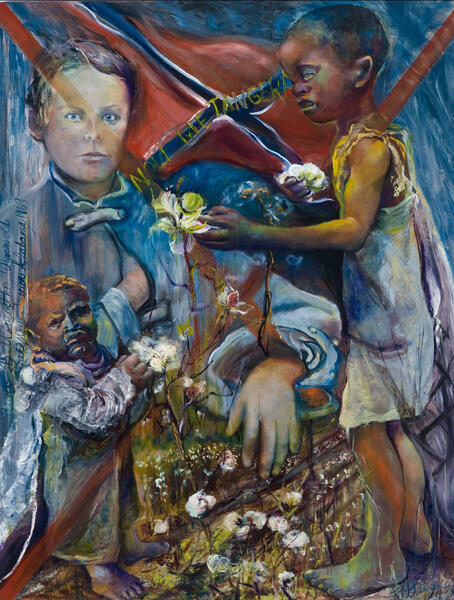 Touch Me Not
Touch Me NotTouch Me Not (60 x 48", oil on canvas, 2015) was completed after the massacre of nine parishioners at Emmanuel African Methodist Episcopal Church, June 2015. Using antique photos, I juxtaposed a white schoolboy ready to restore the Southern antebellum order with the racist Confederate flag threaded through two African American boys picking cotton. Interrelationships reveal a deeper truth, the roots of a pernicious and unrelenting American racism. “The past is never dead. It's not even past.” In the "George Floyd Social Conscience Art Movement" collection, JW Jones, Charlotte, NC.
-
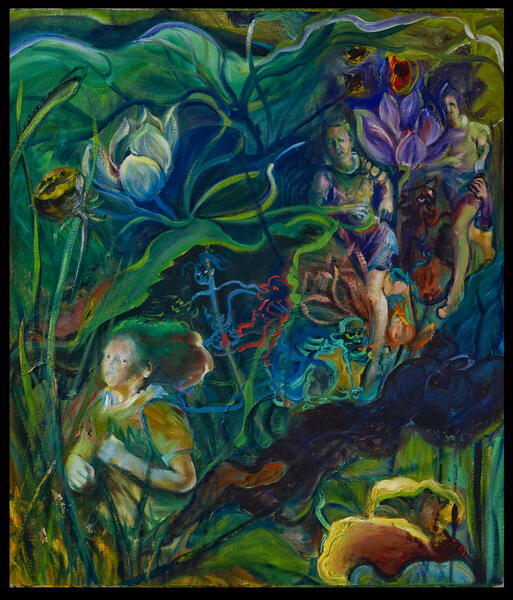 Slogging Thru the Hungry Ghost Swamp
Slogging Thru the Hungry Ghost Swamp30 x 28", oil on canvas, 2016
Donald Trump’s 2016 electoral win of the presidency is a perfect illustration of Faulkner’s insight about the past.The lotus, a Buddhist bodhisattva symbol and “hungry ghosts”, creatures who did not control their appetites during life and are therefore, condemned for eternity never satiated by food, wealth or sex, are the metaphorical environment for the anticipated slog needed to get through the next four years.
-
 I Am Here
I Am Here37 x 27", oil on linen, 2015
A staring toddler crushes her solid leg upon a dying fish and a bewilder father looks on. I believe it is a strange juxtaposition since children are supposed to be cute or playful. This toddler is daring the viewer saying- I AM HERE. She crushes the wild life of the fish. Do not mess with her. Her dad has tight lips and eyes glaring. Distance and tension separates them, which is relieved by an environment of playful dolphins. This painting was a response to a Ragain poem, "Let the Dolphin Dance – A note to my daughter Megan." Ragain, Maj, "A Hungry Ghost Surrenders His Tacklebox". Pavement Saw Press, Ohio, 2006 pp.137-139
-
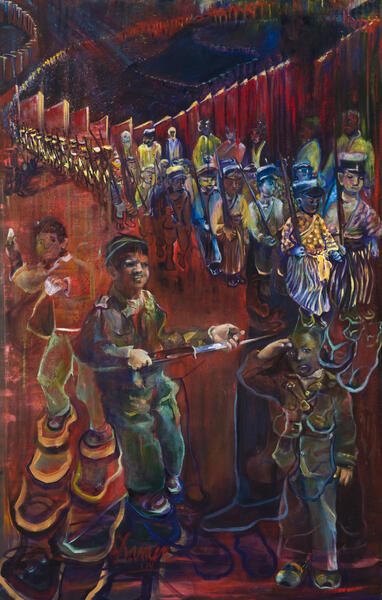 Raised With Walls
Raised With Walls77 x 47", oil on linen, 2014
Several antique photographs were sources for "Raised With Walls - Bad Education". I identify with boys of an era. I feel their desire to please. They are not yet formed but are boys molded within a field of red blood. They are caught in an endless chain of mis-education. It is bad education when young boys are taught to fill boots they are too young to understand.
-
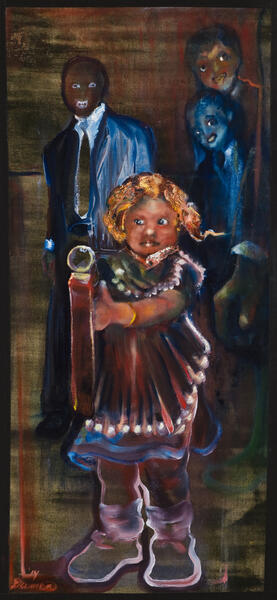 It's In Our Hands
It's In Our Hands23 x 13", oil on linen, 2014
A small black and white snapshot, taken around 1948 inspires "It’s In Our Hands." The photograph both disturbing and provocative is of a very young girl holding a rifle. Around her are laughing adults as she struggles to hold it. My imagination wandered and I saw those adults as apparitions representing teachers of death and of unthinking callousness. My subtle use of red forebodes the loss of blood. Over the ensuing five decades, American society has witnessed an alarming rate of child deaths due to rifles and handguns.1. Guns kill children daily. Most often it is not the deranged mass murderers doing it, rather, it is the parent’s gun that kills. The National Rifle Association obfuscates the truth about children’s deaths. 2. Moreover, rifles and handguns are more lethal, lightweight and easy to use. It is never a laughing matter when a child has a gun.
http://www.nasponline.org/resources/crisis_safety/Youth_Gun_Violence_Fact_Sheet.pdf 2. http://www.nytimes.com/2013/09/29/us/children-and-guns-the-hidden-toll.html
-
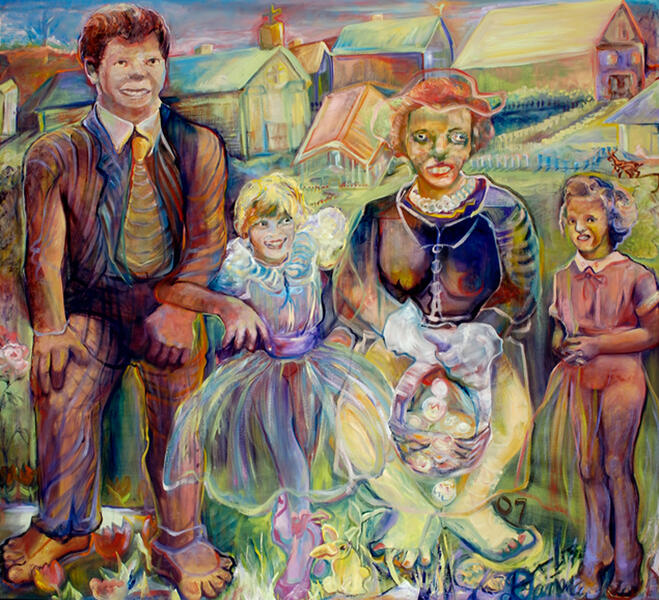 Easter Sunday Portrait
Easter Sunday Portrait67 x 84", oil on canvas, 2007
I found an old Kodachrome color family photograph. My family is all dressed up for an Easter Day Portrait. The photo portrayed that perfect 1960 family: strong dad, adorable daughters dressed in pastels and a beautiful mom. But this painting is not a copy of the original. Instead, I saw something else: a stilted man, a girl with a snarly smile separated by a mother from the other girl, a gleeful girl from a more current time. The mother's face is skull like in her Easter bonnet. She is almost a monster pushing out children like so many decorated Easter eggs. This painting brings forth references from art history and prevailing cultural myths, as well as, a cynicism toward such myths.
-
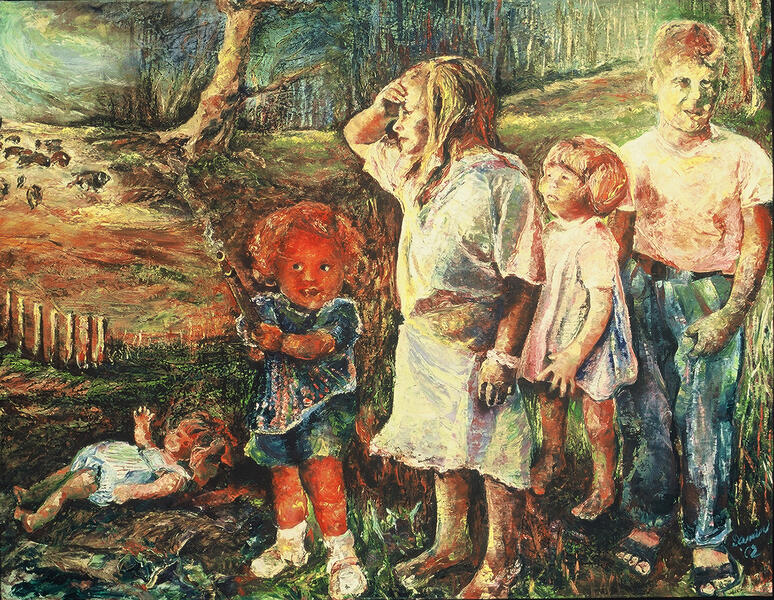 Who Are You, Children?
Who Are You, Children?Who are You? Children? (48 x 62", oil on canvas, 2001) This painting was started during the idyllic summer of 2001 while I basked in the sun drenched days and intellectual bliss of the Fine Arts Work Center, Provincetown, MA residency. It was completed after the horrific events of September 11, 2001 and therefore took a ominous turn. Here are five archetypes: the impish demon, the seer, the male and female hapless witnesses and the fallen doll. My poet colleague, Maj Ragain, composed a response poem, “The Ancient Ones at Trail’s End,” and ended it with these lines: I am the sighted one. Only I can see what is coming for us. Our flame headed sister has fired her last musket ball at the wounded moon. The beasts have found the breech in the fence. This is the time we have feared. - Maj Ragain I interrogate myself with this painting. As I suspect most people did after those fateful events. Here follows Ragain’s complete poem: The Ancient Ones at Trail’s End A Response Poem to Who Are You? Children? We are not children. We walked out of the wood’s womb before the first light. We wait now at the edge of razor grass, picketed by the wooden teeth fence. Down the long, narrow trails, we linked hands, the five of us, our legs kissed by summer, poison oak, trumpet vine, nightshade. In the clearing, we unraveled into who we had always been, the heavy bucket of the skull, the noise in the chest, the hands that long to fly away like strange, knuckle-winged birds, to call back to us from treetops. I am the sighted one. Only I can see what is coming for us. Our flame headed sister has fired her last musket ball at the wounded moon. The beasts have found the breech in the fence. This is the time we have feared. - Maj Ragain
-
 Hanging By A Limb
Hanging By A Limb12 x 12", oil on canvas, 2001
September 11, 2001 occurred while my daughter was in the fourth grade. Her school, in Montgomery County, MD, about fifteen miles outside of DC was located in an area where parents were told not to pick up their children. Apparently there was concern that the roads would become too congested. Joanna told me that the kids in her class gave each other comfort. One girl's father was an American Airlines pilot and the kids rallied around her. I concentrated on the mutual comfort the children shared while the monkey holding on to the tree limb represents the horrors of the day's events.
-
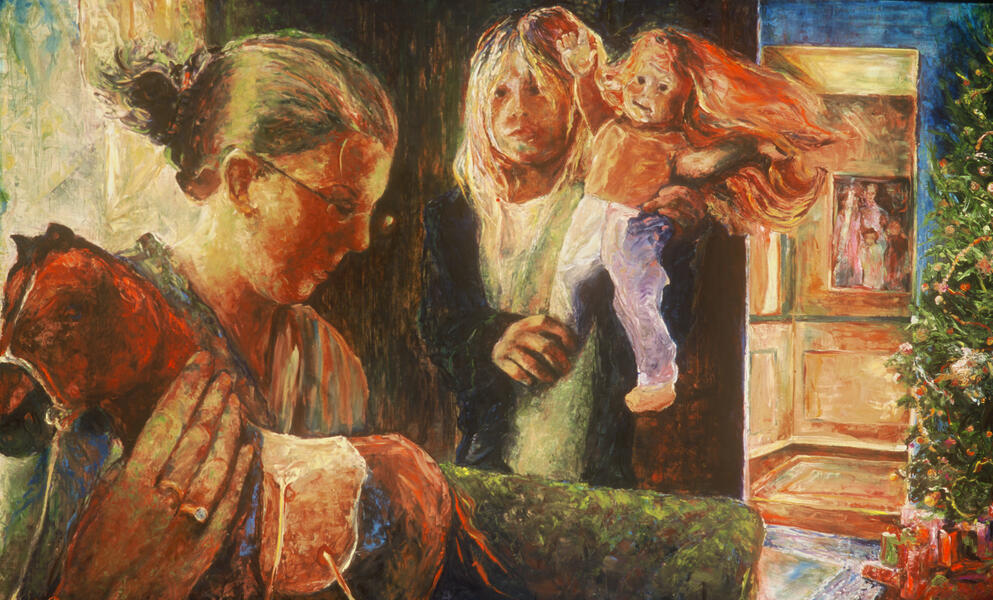 Gifts
GiftsGifts (44 x 72", oil on linen, 2000)- Three generations are pictured here. In the foreground two sisters have just opened a Christmas gift. The one girl gazes at an unknown sight and her eyes mirror the doll’s. Their mother is the recorder of this still moment in what could have been a frenzied morning. In the sunlit hallway is a blurred painting. Look closely you will see another Christmas morning pictured.
-
 Long Immortal Day
Long Immortal Day60 x 30", oil on canvas, 2000
Originally four-year old Adriana was photographed naked, holding a towel after shedding a sandy, wet bathing suit. Since the day lily represents the immortality of a child’s day, she holds it. Adriana is that sweet child frozen in time. The child herself has a different concept of time. “Who shall say if the day was too brief, For the flower, if time lack? Had it not, like the children, all Time In their long, immortal day? Ibid, p. 77
It Is Rumored - Two Sided Scroll 2011
The “It is Rumored” project began with a question. “Why is this beautiful place in the Chesapeake Bay called Bloody Point?” The answers to that question led me to paint a 84 x 48" free hanging scroll on Mulberry paper using ink, watercolor, acrylic and gouache paints. The stories associated with this Point are unquestionably bloody. This scroll suspended by an American Eagle door knocker is inspired by mysteries that are legendary surrounding Bloody Point: the site of many horrific documented and rumored events. It was rumored that dead and dying slaves were tossed from ships at this deepest point of The Bay after the Middle Passage. Unquestionably many thousands of enslaved men and women were transported through these waters. Time is painted as “all over” flowing stories. The length of the scroll suggests the mysteries hidden by the water’s depth and obscured by time. A hung pirate is left to rot surrounded by the abundant beauty and bounty of The Bay even as Native Americans are slaughtered. To convey the idea that rumors and time obscure facts and sow confusion, the two paintings are mounted back-to-back. Consequently, while looking at one side, one can see the muted impressions of the other narrative image. Even though this is one painting, there is neither a front nor back. The image can be seen from both sides, encouraging many perspectives.
-
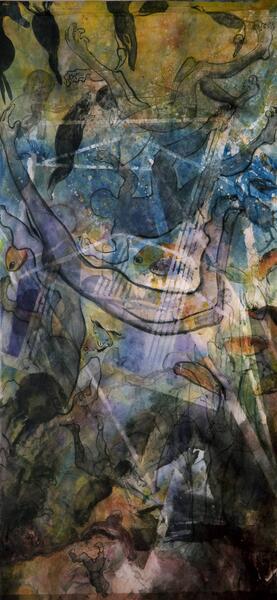 It is Rumored: Side A
It is Rumored: Side A84 x 40", Chinese ink, watercolor, acrylic, gouache on Mulberry paper, suspended from a wood dowel and an American Eagle door knocker. I imagined Side A of “It is Rumored” as a remembrance of murdered slaves who were cruelly tossed from ships. There is no documentation from insurance claims to support the practice of disposal of dead or near dying slaves at Bloody Point. But it is documented at other sites off the coast of Africa. (1) Although it does seem possible that if one wanted to hide nefarious deeds, the deepest part of the Chesapeake Bay would hide the evidence. I imagine a young woman attempting to hold up her newborn infant and a young man struggling to swim despite the chain weighing him down. Light filters through the murky water as figures fall toward an unnatural light. (1) http://msa.maryland.gov/msa/refserv/bulldog/bull01/bull15-18/html/bull15-18.html Haley, Chris. "A Point of Land On Kent Island." The Archivists' Bulldog: Newsletter of the Maryland State Archives, Vol. 15, No. 18 (Sept. 24, 2001)
-
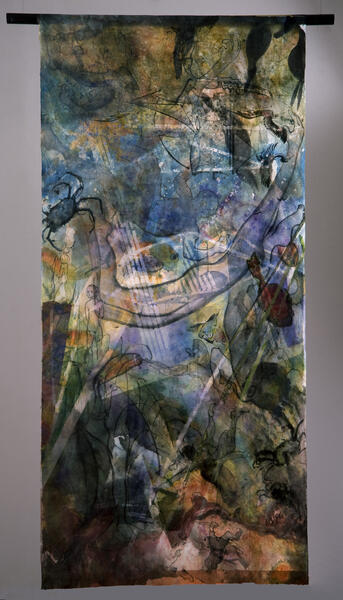 It is Rumored: Side B
It is Rumored: Side B84 x 40", Chinese ink, watercolor, acrylic, gouache on Mulberry paper, suspended from a wood dowel and an American Eagle door knocker. I imagined the B-side of “It is Rumored” as a remembrance of massacred Native Americans who unwittingly arrived for an "interview” only to be killed by colonists. There is a court record documenting the trial of a pirate who murdered four seamen. The pirate was tried, condemned to death by hanging and his body was left to rot at Bloody Point. I imagined the bounty of The Bay and its surrounding land. Crab and Rockfish literally leaped out of its waters, oysters covered it shallows. The surrounding land was verdant with timber, fertile for farming and of course, the tobacco cash crop, which made many planters wealthy and drove the economy for the enslavement of Africans.
-
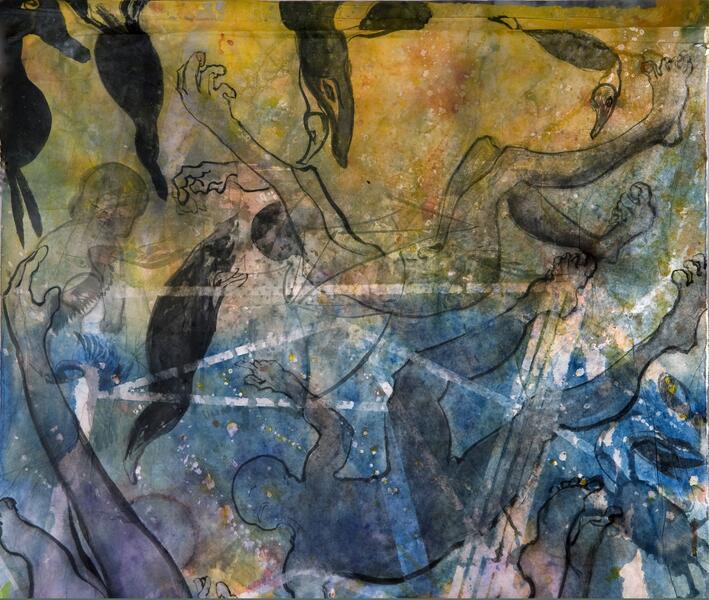 Detail of the Upper Part of A side of It is Rumored - Bloody Point
Detail of the Upper Part of A side of It is Rumored - Bloody PointWater fowl feed as bodies struggle to survive.
-
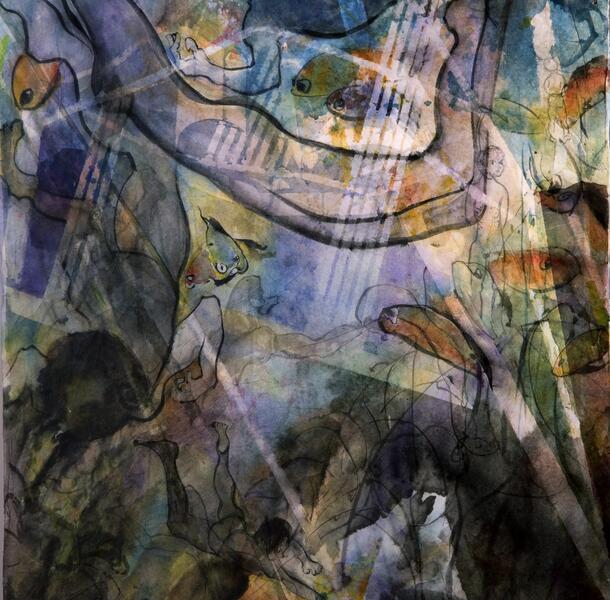 Detail Part of the Middle of Side A of It is Rumored
Detail Part of the Middle of Side A of It is RumoredOne is able to see the muted image of the hung pirate, as fish swim by and falling figures descend to the abyss.
-
 Detail of the Lower Part of A side of It is Rumored
Detail of the Lower Part of A side of It is RumoredSide A lower section is dense with black ink and saturated color creating a more chaotic scene.
-
 Detail of the Upper Part of B side of It is Rumored
Detail of the Upper Part of B side of It is RumoredSide B upper section: A ship under sail, one that brought slaves across the ocean is reflected in the water. Bubbles of expelled air are released. Elegant Blue Herons are reflected as other waterfowl dip into the Bay searching for food. One can see through to the other side, the falling side. Beauty and dread are combined within each frame.
-
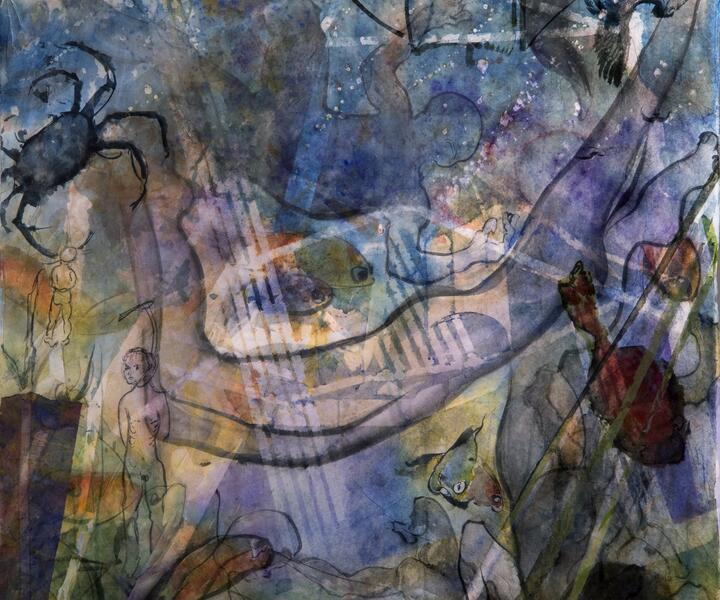 Detail of the Middle B Side of It is Rumored
Detail of the Middle B Side of It is Rumored -
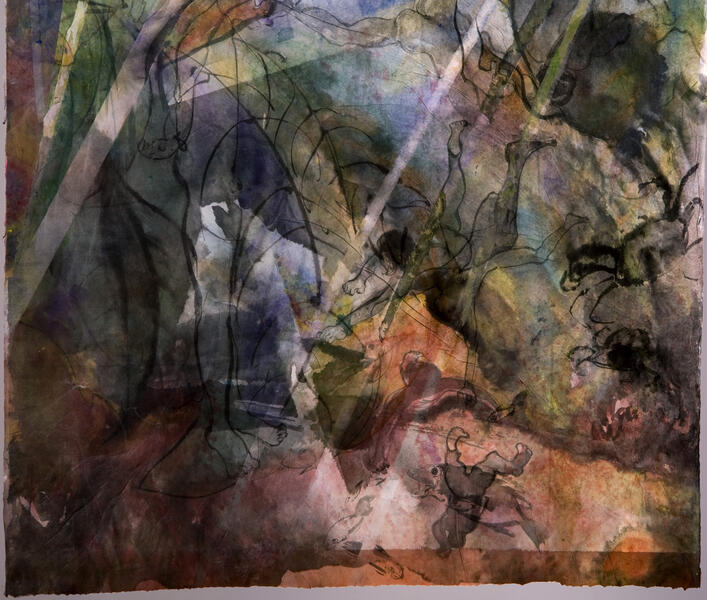 Detail of the Lower Part of B Side of It is Rumored
Detail of the Lower Part of B Side of It is RumoredThe veins of the tobacco leaf are juxtaposed with falling figures.
-
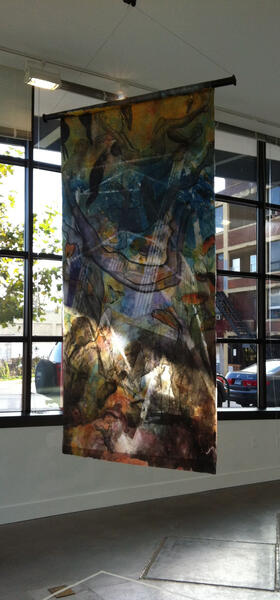 Installation of It is Rumored
Installation of It is RumoredInstallation shot of Side A of "It is Rumored" from "Altered Truths - Fractured Myths" two person show with Oletha DeVane, at City Arts Gallery, Baltimore MD, Nov 2011- Jan 2012
-
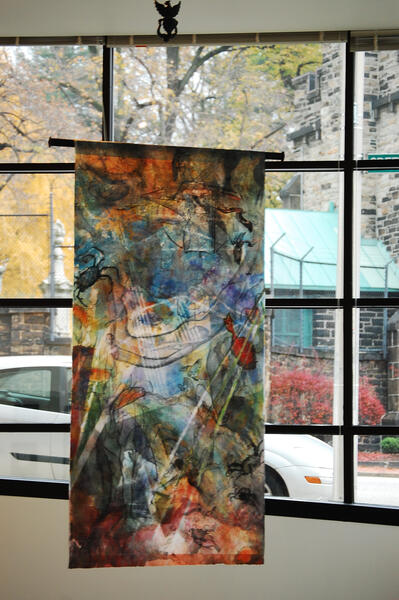 Installation of It is Rumored - Bloody Point
Installation of It is Rumored - Bloody PointInstallation shot of Side B of "It is Rumored" from "Altered Truths - Fractured Myths" two person show with Oletha DeVane, at City Arts Gallery, Baltimore MD, Nov 2011- Jan 2012






































